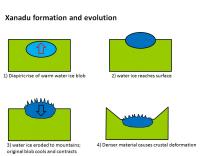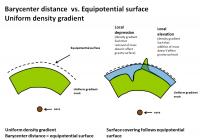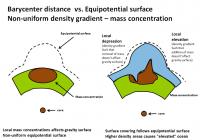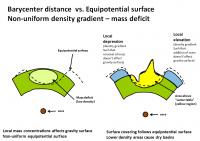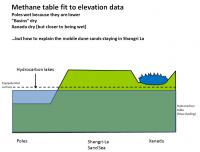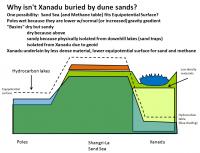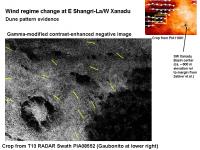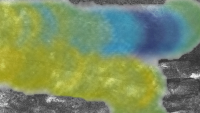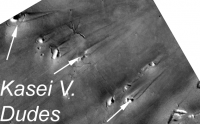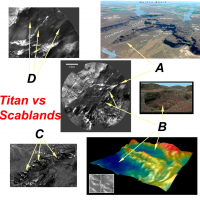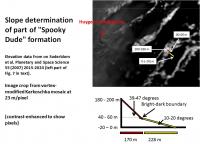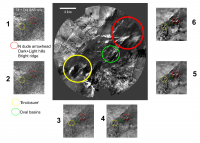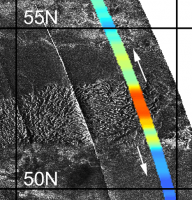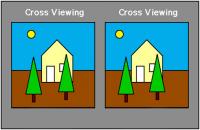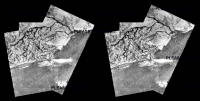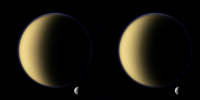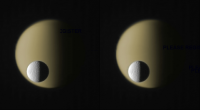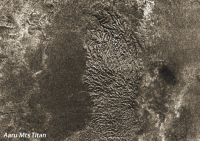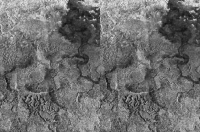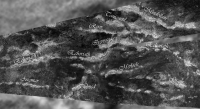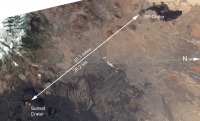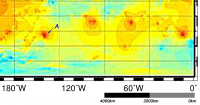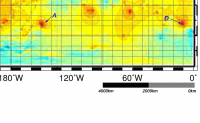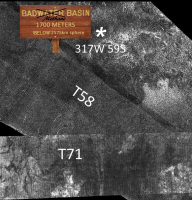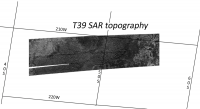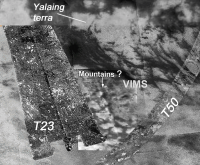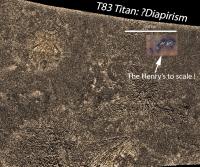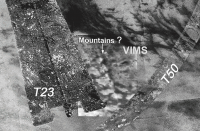Printable Version of Topic
Click here to view this topic in its original format
Unmanned Spaceflight.com _ Titan _ Titan's topography
Posted by: Juramike Apr 12 2009, 12:44 PM
Recent article in Science by Zebker et al.:
Zebker et al. Science in press, "Size and Shape of Saturn's Moon Titan". doi: 10.1126/science.1168905
(published online April 2, 2009)
Link to abstract (pay-for article): http://www.sciencemag.org/cgi/content/abstract/1168905
Article on spaceref discusses this paper: http://www.spaceref.com/news/viewpr.html?pid=27912
Figure 3 from the Science article is a global elevation map relative to barycenter.
Key points of article:
- Poles are squished - might explain why lakes are up there
- "Mountains" aren't necessarily elevated - they might've sunk down into the crust to form "a basin of their own creation".
- (quote from spaceref. article)
- Large scale features do not appear correlated with elevation
- Xanadu and Tseghi are BASINS! (ca. -600 m to barycenter)
- Adiri is higher than Xanadu (by almost 1 km)
- Dilmun is also pretty elevated (+ 400 m relative to barycenter)
- highest elevated terrain on Titan seems to be region around "Adiri junior" in the S Senkyo "basin" at ca. + 600 m above barycenter
- Shangri-La "basin" is elevated +400-800 m ABOVE Xanadu (using barycenter elevations in Fig. 3)
"Xanadu seems to be systematically lower than other parts of the equatorial belt, and not uplifted like most mountainous areas on Earth." (quote from Fig. 3 caption in article)
-Mike
Posted by: Juramike Apr 12 2009, 03:32 PM
Here's a cartooon showing how Xanadu could have formed:
1) A diapiric rise of warm low density (mostly due to warmth) water ice
2) reaches surface; erosion begins
3) cools and contracts; ice now denser (heavier) than surrounding crust; crustal deformation begins
3) regional depression begins as old diaipir sinks due to now-cooled higher density material
Quote from the spaceref article:
'One of the really surprising finds that we have from this, is that the largest apparent continent is lower than the average elevation on Titan, as opposed to higher than the average elevation, as we have on the Earth,' Zebker said.
'My favorite explanation is that the material that forms the mountains is simply more dense than the material surrounding them,' he said. That would result in the mountains pushing down the surrounding crust, effectively putting the mountains in a basin of their own creation.
On Earth, the situation is the reverse: The crust that lies under the oceans is denser than the material that makes up the continental crust, where mountain ranges are built up.
'The things that we would expect to exist on the surface of Titan would either be solid hydrocarbon materials, essentially frozen ethane and methane, and that is fairly light, and then frozen water ice, which is denser,' Zebker said. 'If the mountains are composed of water ice and the plain features in between are composed of these solid hydrocarbons, that could lead to this kind of a situation.' "
Posted by: Juramike Apr 12 2009, 03:46 PM
The Science article is in reference to the Barycentric center of Titan.
This could be different from the equipotential surface.
If I understand this correctly....
In a perfect world, with a uniform density gradient, the elevation and equipotential surfaces pretty much match:
A large mass concentration (high density crustal materials) can cause a localized gravity well, and cause the equipotential surface to bulge out. (More mass, more gravity, more "pull"). So you can get an elevated ocean that covers a elevated (based on barycenter distance) rise.
A mass deficit (lower density crustal materials) can cause a localized gravity deficit and cause the equipotential surface to dip in. (less mass, less gravity, less "pull"). This could cause a basin that one would think should be flooded, to be dry. The water table responds to the equipotential surface, not the elevation.
http://en.wikipedia.org/wiki/Geoid
Posted by: Juramike Apr 12 2009, 04:00 PM
So now a Big Question:
Why are the poles wet, the equatorial Sand Seas dry, and Xanadu dry and sand-free?
The elevation difference can explain why the poles are wet:
(published online April 2, 2009):
If we posit that the lakes are surface expressions of a more or less continuous liquid organic "water table," then the lower elevations of the poles could lead to the observed preponderance of lakes at high latitudes. However, whether the polar surface intersects a methane table depends on its distance from a constant gravity potential surface, and not the on its elevation from the barycenter, because the equipotential may be depressed as well at the poles.
But keeping lower lying downwind Xanadu free from Shangri-La's dune sands is harder to explain.
If the equipotential is depressed at Xanadu (due to a lower overall density of crustal materials), this could explain why the mobile dune sands remain in Shangri-La (which is higher barycentric elevation) and don't fill in Xanadu.
Otherwise some funky physical barriers would need to be invoked.
[The sand seas could be isolated from the north polar lakes due to many reasons: an isolating temperate airfall deposit, lack of sand reservoirs, lack of winds carrying material into the poles, and also sands getting trapped by the lakes]
This Science paper is awesome. It raises a lot of really tough questions.....
Posted by: ngunn Apr 12 2009, 08:24 PM
Thanks for starting off a discussion on this. One fairly safe conclusion would seem to be that for Titan a triaxial ellipsoid is a very poor fit to an equipotential. The latter must be very bumpy compared with what we're used to. But as you say there are problems everywhere with this (which likely means that it will be a very productive observation in the long run). Are Xanadu's mountains dense, or light and porous? We have observational evidence for the latter, yet here it is suggested that they are denser than surrounding terrain and thus capable of making their own basin to sit in.
A general observation (not necessarily helpful): topsy-turvy topography is less difficult to explain away if ALL the surface materials (except the liquids) are of very low density, i.e. fluffy or aerated.
Posted by: Doc Apr 12 2009, 08:44 PM
Forgive my ignorance ngunn but exactly what was that observational evidence that indicates light and porous material in Xanadu?
Posted by: ngunn Apr 12 2009, 09:03 PM
It came from RADAR reflectance observations of the dielectric properties if I remember correctly. It was a while ago now, but it led to extensive discussion here and elsewhere about possible underground cave systems (likened to Xanadu in the poem). Emily's Planetary Society blog had at least one entry on it at the time, which may or may not have been called something like 'Caverns measureless to man'. Sorry not to be more specific - I wish I was better at keeping references.
Posted by: Juramike Apr 13 2009, 01:45 AM
Nigel's right, the most recent evidence comes from a Janssen article on dielectric constant (discussed http://www.unmannedspaceflight.com/index.php?s=&showtopic=5143&view=findpost&p=137820: Titan's Mid Latitudes thread, post 6). The dielectric constant in some parts of Xanadu was waaay too low to be of any normal materials, even very low dielectric organics.
Dielectric constant is modified by fluffiness (pores). Volume scattering can make the material appear to have a much lower dielectric constant. It was postulated that volume scattering was responsible for the apparent low dielectric constant.
Posted by: Juramike Apr 13 2009, 02:07 AM
The channel drainage pattern in W Xanadu in the T13 SAR RADAR Swath is very consistent with the Zebker elevation data.
(For E Xanadu, check out Fig 2b the freely available LPSC abstract: http://www.lpi.usra.edu/meetings/lpsc2009/pdf/1037.pdf. For W Xanadu, check out Fig. 7 a and b in Lorenz et al. Planetary and Space Science 56 (2008) 1132-1144. "Fluvial Channels on Titan: Initial Cassini RADAR observations." doi: 10.1016/j.psss.2008.02.009
The dendritic drainage pattern across the T13 RADAR Swath pattern is to the S, towards the lowest regional barycentric elevation determined to be in SW Xanadu.
Thus, the elevation data seems to agree with the local geoid in W Xanadu.
Back to the tough question, what prevents the Shangri-La dune sands from dropping down into the SW Xanadu low elevation basin???
****
The Zebker paper also makes the airfall origin of the sand sea dunes difficult to explain. If atmospheric deposition and sintering is supposedly occuring all over, it should occur over Xanadu. The regional gradient should make it collect in the SW Xanadu basin. According to this idea, there should be a dune sea filling in the SW Xanadu depression. But there isn't. (At least no dunes are seen by RADAR, and ISS shows a bright coating rather than a dark dune sea.) There is, however, a smooth (RADAR) dark area seen with channels crossing into it, again going downgradient.
Posted by: rlorenz Apr 15 2009, 03:31 AM
As another post noted, Xanadu has very peculiar dielectric properties - its radar echo is quite
depolarized, suggestive of porosity (see the Janssen paper)
There is also the result published by Buratti et al of the VIMS team suggesting that the near-IR
phase function of Xanadu suggests rougher material (at the microscale, IIRC)
Posted by: rlorenz Apr 15 2009, 03:39 AM
...
A general observation (not necessarily helpful): topsy-turvy topography is less difficult to explain away if ALL the surface materials (except the liquids) are of very low density, i.e. fluffy or aerated.
For your first remark, we'll need to wait to see what the published gravity field is. If the 3rd order terms are, in
fact low (at one time the retrievals suggested they might not be), then in fact a triaxial ellipsoid IS a good fit
to the EQUIPOTENTIAL.
Maybe (since you are referring to the shape measured from radar) you mean that a triaxial ellipsoid isnt a good
fit to the figure ?
As far as liquids draining downhill goes, there does seem to be a consistency between lakes at high latitudes, and
the hint of a tendency (with incomplete sampling) in my fluvial paper for rivers to flow poleward, and the
difference between the topographic shape and reasonable geopotentials.
The low-latitude longitudinal contrasts (viz, low Xanadu vs the dunes) is harder to explain, as is the orientation
of the dunes themselves. I sometimes wonder about albedo-driven wind (i.e. sea-breeze type circulations -
with effectively katabatic flow away from high albedo regions).
The Zebker et al (you can call me al !) paper about the shape - like the Lorenz et al spin paper last year -
is I think just going to be the start of a long and complicated story.
Posted by: ngunn Apr 15 2009, 09:34 AM
On the ellipsoid vs. equipotential I'm happy to be corrected. (I can't pretend I meant something different.) Like you say, we're just at the beginning.
I'm very interested in your idea of albedo-driven winds. For some time I've been trying to shake off habitual assumptions about the importance of gravity in distributing surface materials on Titan. At the Huygens landing site for example there seems to be evidence of fairly recent fluid flow from at least two directions. To me that suggests something like a storm-driven flood, followed up by some gravitational trickling. Of course lighter materials would pay even less heed to gravitational constraint.
Even on high-g Earth with heavy silicate sand there is striking evidence that sand seas don't follow equipotentials. The Taklamakhan in western China is a good example. It is much higher at it's western end. I was lucky enough to be there last year and was amazed to see sand 'mountains' piled high on the Pamir plateau, deposited near the head of the steep valley that leads up there from the desert.
Posted by: Juramike Apr 15 2009, 02:34 PM
Looking at channels in the RADAR Swaths, I haven't seen any obvious places where the apparent flow direction is different from the proposed barycentric elevation differential (Fig 3 in Zebker et al.).
[BTW, the actual swath traces and their altimetry data can be seen in the figures in the text. This was really helpful.]
As far as I can tell, the barycentric elevation data seem to fit the equipotential surface (geoid).
Why Xanadu is not filled in baffles me...
-Mike
Posted by: ngunn Apr 15 2009, 03:06 PM
Perhaps dune particles have a finite lifetime on Titan, and some areas like Xanadu are simply made of the wrong materials for producing them. I agree with your point in an earlier post that they can't be falling from the sky. It has always been awkward to explain how some areas are swept clean if that were the case.
Posted by: Juramike Apr 15 2009, 03:18 PM
of the dunes themselves. I sometimes wonder about albedo-driven wind (i.e. sea-breeze type circulations -
with effectively katabatic flow away from high albedo regions).
Here is a detail of the dune pattern near the E Shangri-La/W Xanadu boundary using Amazing Dune-O-Vision (gamma-modified, contrast enhanced, negative image) for a portion of the T13 Swath. I highlighted the dune pattern orientation in some areas using yellow lines.
There seems to be a sudden turn southward near Xanadu as the dunes smack into Xanadu. For a sea-breeze circulation, I would have thought that the off-Xanadu circulation would make the dune pattern "confused" or dissappear in a marginal zone around Xanadu. Instead, while the dune orientation changes, it remains very clear right up until hitting Xanadu. (Also indicating that the Xanadu margin is not much of a topographical barrier)
And the dune sand migration seems to bend to the S when it starts to go across Xanadu.
Is this vector change sufficient to divert sand flow around the depression instead of into it? Where does the sand eventually end up?
-Mike
Posted by: ngunn Apr 15 2009, 03:44 PM
Correct me if I'm wrong (again), but aren't these dunes consistent with winds blowing alternately one way then the reverse? In that case you could in principle have a single longitudinal dune where the wind regime was 60% W, 40% E at one end and 60% E, 40% W at the other. That would fit with the albedo idea, I think, and it would provide geographical confinement for the sand seas.
Posted by: Juramike Apr 15 2009, 05:10 PM
If I understand this correctly, the dunes line up along the vector addition product of the alternate wind vectors.
So 50% winds blowing from the NW + 50% winds blowing from the SW will give an EW dune (with the mobile dune particles kinda marching to the E).
The change in wind direction could be daily, or seasonal. [http://www.tec.army.mil/research/products/desert_guide/lsmsheet/lslinear.htm]
(Another clue to average wind direction vector is dune bifurcation, in case of Y-junctions, the "stem" of the Y is downwind.)
The key is that to make a stable linear dune, the difference between the two alternate vectors has to be pretty large. Otherwise, the linear dune will decay into a barchan-type dune.
Check out: http://www.comphys.ethz.ch/hans/p/457.pdf
Extending this to the linear dune direction change to the SSE vector in E Shangri-La/W Xanadu, BOTH alternate wind vectors need to be shifted. So the evidenced wind regime near the margin should be (assuming a 90 degree alternate vector (theta-w) difference) WNW alternating with NNE winds.
Posted by: Juramike Apr 15 2009, 05:32 PM
Two different wind regimes, but with one component larger than the other, can form linear dunes with the vector addition product.
But sand movement will be the time-average of the relative strength of the two alternate regimes.
The sand movement vector can be different from the dune alignment vector.
Check out this section of a book preview http://books.google.com/books?id=VSQOAAAAQAAJ&pg=PA68&lpg=PA68&dq=linear+dunes+vector&source=bl&ots=ksCE6or1KP&sig=P8zhOWoI_jyuPyKUATjgr3xVc_0&hl=en&ei=ohHmSZGQHKDjnQeN98SxCQ&sa=X&oi=book_result&ct=result&resnum=4#PPA67,M1
(Note how the dune pattern changes around Australia due to interaction of winds with the seasonal anticyclonic high. This might be an example of what Ralph was mentioning above, i.e. Xanadu having a permanent pressure system.)
Posted by: ngunn Apr 15 2009, 06:06 PM
Mike I'm having trouble reconciling what you describe with the recently published wind vector map where the arrows seem mostly more or less aligned E-W with the dune crests. It is agreed that there is 180 degree ambiguity in the inferred wind direction at any one locality. It has also been suggested that the wind directions could reverse with the tidal cycle. If that's so then presumably material is transported both ways alternately along any particular section of dune. Even a slight preponderence of one direction over the other would be enough to produce the teardrop shapes we see around 'islands', but following the direction inferred at one point could lead you to a place where the preponderance, and therefore the net transport, is the opposite way. There need be no discontinuity in the dune pattern between the two locations, which might be at opposite sides of a sand sea.
I'm sure I'm oversimplifying . .
Posted by: Juramike Apr 15 2009, 07:17 PM
The maps show the linear dune orientation. The linear dune orientation is based on the averaged wind vector. The alternating winds come from two different directions. These could be daily (tidal) or seasonal.
To make a linear dune, the alternating wind vectors need to be about 90 degrees apart or more.
Looking at a linear dune, the averaged wind vector could be in either direction of the line. Looking at the forking pattern can determine which is the correct average direction.
The GCM for Titan predicted an overall westerly course for the average winds on Titan (so average wind vector from the E). The observations show an average westerly vector for the surface winds. This is in contrast to the predicted GCM model (by Tokano et al.).
Check out: http://www.astronomy.com/asy/default.aspx?c=a&id=7972
And you are correct, a typical sand particle will have a zig-zag path due to the alternating winds, but will run downcrest. If I understand it correctly, a strong wind from one of the alternating components could cause it the particle to "shift" it's path to the next dune set during it's zig-zag path (it zigs more than it zags). Thus the net sand flow could be off-angle to the dune crests.
Posted by: ngunn Apr 15 2009, 07:36 PM
Hope I'm not trying your patience, but this is the bit I don't quite get. What you say implies winds that blow, in general, at angles of 45 degrees or more to the equator. But this is not what Huygens observed, which was roughly E-W movement (parallel to the pair of nearby dunes), with reversals. It also seems at odds with the way we see clouds behaving, forming more or less latitudinal streaks.
Posted by: Juramike Apr 15 2009, 09:40 PM
If I remember correctly, the GCM wind field changes as Titan goes around Saturn (there is a tidal component). The average vectors predominate from one direction, then alternate with another that is roughly orthogonal.
I'm not sure how this all fits with the Huygens descent data (which also changed direction with altitude):
Did the probe descend during a "typical" predominate wind day?
Are the winds that Huygens encountered typical of the surface winds?
What kind of winds do the banded clouds indicate? (And how do they relate to surface winds?)
Posted by: ngunn Apr 15 2009, 09:59 PM
I'm just reading the transcript of the Titan spin CHARM now and it includes an explanation of the dune formation consistent with yours, that is: two wind directions separated by 120-odd degrees. But it also mentions the Tokano et al climate model which has winds switching between W-E and E-W with the seasons (not with the tides - I got that wrong before). So which is it? Do the dune particles move inexorably eastward, albeit by north-south zig-zags, or do they move alternately eastward and westward? The implications of the two are very different.
Posted by: Juramike Apr 16 2009, 02:45 AM
From looking at RADAR images, it looks like the W sides of most of the sand seas are lacking in dunes, while the E sides have dunes.
I'd take this as observational evidence that net flow is eastward.
Posted by: Juramike Apr 16 2009, 02:46 AM
Bingo!
Tokano, T. Icarus 194 (2008) 243-262. "Dune forming winds on the surface of Titan and the influence of topography." doi:10.1016/j.icarus.2007.10.007
Pay-for article, abstract available http://www.sciencedirect.com/science?_ob=ArticleURL&_udi=B6WGF-4R1MF54-2&_user=10&_rdoc=1&_fmt=&_orig=search&_sort=d&view=c&_acct=C000050221&_version=1&_urlVersion=0&_userid=10&md5=80c07c751f98bdb82d76a3a08f755d78.
Here is an additional explanation of the GCM with pretty diagrams: http://www.esa.int/SPECIALS/Cassini-Huygens/SEMF9F9RR1F_0.html
Posted by: ngunn Apr 16 2009, 08:50 AM
So, four possibilities:
1/ There is a sink of dune particles on the west facing 'coasts'.
2/ On reaching a 'continent' the dune particles skip right over without sticking and start again on the other side.
3/ There is a net eastward flow over much of the sand seas but the net flow reduces to zero at their eastern margins.
4/ Come back in half a million years to see the Xanadu sand sea and the Shangri-la mountains.
Nice that the Tokano paper predicted the Xanadu basin - thanks for posting that.
Posted by: ngunn Apr 16 2009, 10:01 AM
A further thought on albedo-controlled winds. Since the dunes themselves are dark, winds that systematically blow from light to dark would constitute a positive feedback mechanism tending to accentuate the separation between light and dark areas. This would be akin to the situation on Iapetus, albeit involving a totally different physical process. All you would need to start it off would be a slight initial tonal dichotomy or a slightly uneven supply of dune forming material.
Posted by: ngunn Apr 16 2009, 10:32 AM
Let's take this even further into the realm of guesswork. If a computer simulation of this positive feedback system were run it would not surprise me if the light and dark areas evolved towards a state where their EW extent became roughly commensurate with their NS extent. Since the feedback system is confined approximately between 30N and 30S that would lead to 6 alternating light and dark areas ranged around the equator, i.e. 3 major sand seas separated by 3 'continents'. I'd love to see a frequency spectrum of the actual longitude distribution of Titan's sand seas.
Posted by: Juramike Apr 16 2009, 11:31 AM
It also means that Xanadu, and processes that operate there, could be a potential source of dune sands.
Since any sands generated in this region would get "swept" away.
Posted by: ngunn Apr 16 2009, 11:38 AM
Possibly, but it also restores - or rather preserves - the credibility of the current 'official' hypothesis that the dune particles form in the atmosphere.
Posted by: Juramike Apr 16 2009, 07:47 PM
Yup. And if you invoke the sands being able to bounce easily across bright terrain (your item #2), it supports the atmospheric deposition hypothesis. Any atmospheric fallout that hits bright terrain could be blown off. But I'm not sure how this would explain the relatively dune-free W margins of the dune seas.
A Xanadu depression makes some of my earlier speculations go bye-bye: it is hard to invoke an earlier sand-sea filling nitrogen ocean without filling in Xanadu as well.
Posted by: ngunn Apr 16 2009, 09:52 PM
That wasn't meant to be a serious suggestion. I take it as read that corrugated terrain would be harder for sand to cross than a flat plain. Neither was option 1. (What are we to imagine - critters lining the beaches and eating the stuff?) Option 3 was the serious one, though on reflection you could have a blend of 3 and 4, with a bright albedo obstacle like Xanadu temporarily arresting an inexorable eastward migration of the sands, only to be overwhelmed in a comparatively swift event when eventually the piling up of sand to the west of it becomes just too great and everything moves to it's next quasi-stable position.
I have also been thinking about disposal of the atmospheric fallout that lands on Xanadu. In corrugated terrain perhaps not all of it blows clean away. Some could be trapped in pockets or fissures too small for current imaging to resolve and too small also to affect the overall albedo of the region.
Posted by: ngunn Apr 20 2009, 11:07 AM
This thread has gone very quiet! In the meantime I have been trying to put some thoughts into words, and I hope I may be allowed the indulgence of a longer than usual post, even if some of it repeats what's already been said. Here goes:
- - -
Ever since we found out that the low latitude dark markings on Titan consist of drifting sands the map of Titan has been giving me a dull headache. It takes sand movement to form and maintain dunes and that means we cannot be looking at a static system. A steady state dynamic system is also ruled out by the presence of a single complete gap in the pattern. Xanadu acts in effect like a giant capacitor blocking the DC flow of sand. The next possibility is AC sand flow - an oscillating system. However, the asymmetries that we see in the sand seas must have taken ages to form, implying a very long time period for the oscillations. There is no obvious driver for such a process. It seems hard to avoid the conclusion that we are looking at a pattern that is somehow being maintained in a non-equilibrium state, hence the headache.
Now for the first time that I am aware of we have, in albedo-driven winds (and wind-driven albedos), a process proposed which would involve positive feedback. Positive feedback is exactly what's required to maintain a system in a non-equilibrium state. Positive feedback can give even a feeble or inefficient process the leverage to transform worlds, creating emergent order that makes no sense in other terms. That's why I find this idea so exciting. It raises a host of new questions and the pleasant anticipation that some of them may soon be answered.
There is a nice symmetry of scales to this explanation too. Sand dunes and the regular patterns they form are themselves emergent non-equilibrium structures maintained by a different positive feedback system involving wind and another partner, in that case local-scale topography.
We are still a long way from knowing that we have the final answer, but that does not worry me at all. I think that at least we can see clearly now what kind of answer we are seeking: a positive feedback mechanism of some sort which can render Titan's sand seas self-confining and its 'continents' self-cleaning. We have in view at last a domain of possible explanations that does not defy reason. The headache is cured.
What about the asymmetry of the sand seas and its strong implication of DC sand flow? No problem. We can have eastward drift and positive feedback operating together. This would likely produce a sand flow regime that is continuous at some longitudes and episodic at others where some underlying property of the substrate - very plausibly albedo - dams the flow. The large scale pattern of the sand seas may indeed migrate eastward over long time scales, with Xanadu simply happening to be the most effective dam operating in the particular configuration that prevails in our epoch.
- - -
I hope Ralph will pay us another visit here and share more of his insights, but even if he doesn't I don't think we've heard the last of this by a long way.
Posted by: ngunn Apr 20 2009, 02:10 PM
A poem:
- - -
The Walrus and the Carpenter
Were walking close at hand;
They wept like anything to see
Such quantities of sand:
"If this were only cleared away,"
They said, "it would be grand!"
"If seven maids with seven mops
Swept it for half a year.
Do you suppose," the Walrus said,
"That they could get it clear?"
"I doubt it," said the Carpenter,
And shed a bitter tear.
- - -
And a piece of music:
- - -
http://images.google.com/imgres?imgurl=http://userserve-ak.last.fm/serve/64s/10168639.jpg&imgrefurl=http://www.last.fm/music/%25E6%25AD%25A6%25E6%25BA%2580%25E5%25BE%25B9/_/And%2BThen%2BI%2BKnew%2B%27Twas%2BWind&usg=__m_pA_4as9kAUmPsDnnTlLJnCdbI=&h=64&w=64&sz=5&hl=en&start=12&um=1&tbnid=dP450DudZ9MQYM:&tbnh=64&tbnw=64&prev=/images%3Fq%3DAnd%2BThen%2BI%2BKnew%2BTwas%2BWind%26hl%3Den%26rls%3Dcom.microsoft:en-US%26sa%3DN%26um%3D1
Posted by: Jason W Barnes Apr 21 2009, 12:50 AM
The dune particles do not form in the atmosphere. The atmospheric haze is about 1 micron across, while the sand particles are like 300 microns across. The stuff that falls out of the atmosphere is 300 million times too small (by mass) to form sand-sized grains.
The haze must be being reprocessed somehow to get the sand grains. We still don't know how that process works, yet.
- Jason
Posted by: Jason W Barnes Apr 21 2009, 12:51 AM
- Jason
Check that -- lost an order of magnitude there. Should be 30 million times.
- Jason
Posted by: Phil Stooke Apr 21 2009, 02:44 AM
What's an order of magnitude among friends?
Phil
Posted by: Juramike Apr 21 2009, 03:06 AM
If Xanadu is "self-clearing" then the dune particles must be going around the southern edge of Xanadu. (The dune pattern in W Xanadu indicates a southern flow)
So you'd expect to see an ISS-dark and RADAR-dark dune sea somewhere along the southern margin...but you don't.
One possibility is if there is a temperate/polar bright deposit that forms faster than the dune seas move. So instead of dark dune seas forming, there are bright smooth deposits that form in the temperate regions in south-central Xanadu.
In effect the dune seas get "tamped down" and covered up by an ISS-bright atmospheric deposit. So limited "equatorial dunes" in the temperate regions, the deposit seals up the sand supply.
So in the big picture of timing of features on Titan, that would imply:
Temperate/polar atmospheric deposits>dune seas>other process (save cryovolcanic outlflows)
This seems to fit not only Xanadu but the rest of the temperate regions in general.
I'll bet that the normalized brightness of Mezzoramia is still not as dark as that of Shangri-La.
(Another piece of evidence, look at craterforms: not much in polar/temperate regions, some in dune seas, but pretty much everything exposed in Xanadu)
Posted by: ngunn Apr 21 2009, 08:06 AM
Not necessarily. There may be no flow across or round Xanadu at this particular epoch but rather a very gradual encroachment at its western margin. When eventually enough of it is covered a lot of sand may cross in a relatively short period.
I do think though that there must be some net leakage of sand to temperate latitudes where maybe it becomes damp and less mobile. A lot of dark streaks seem to be diverging from the tropics.
RE "The dune particles do not form in the atmosphere"
EDITED LAST PARA:
I expressed myself sloppily there, and thanks Jason for pointing that out. On the respective particle sizes of haze and sand, I'm not forgetting that there must be a processing step or five to get from the former to the latter, if that is indeed what happens. The point as it relates to this discussion, though, is whether all parts of Titan receive equal doses of the raw material for making sand or whether it has a more localised origin. I was merely pointing out that the albedo winds idea is consistent with virtually any origin for the sand particles, including an atmospheric source for the material, whereas some other conceivable explanations for their uneven distribution might rely on localised sources and sinks.
Posted by: ngunn Apr 21 2009, 03:36 PM
I've just peformed an experiment which crudely simulates what I think happens to the sandflow at Xanadu. It only took a few minutes to set up. No pics unfortunately but here's what I did.
I set up an airtrack at a slight gradient. Above the airtrack I positioned a hairdryer angled slightly downwards but facing the airtrack's uphill direction. Before starting the airflow to the track I placed three pucks well spaced out along it and turned on the hairdryer.
On starting the airflow to the track the pucks began moving downhill, remaining evenly spaced. As the first one approached the hairdryer it stopped and reversed back up until the second puck ran into it. Now joined together (blu-tack) the first two pucks came to a halt in front of the hairdryer. When the third puck caught up with the first two they collectively overcame the headwind from the hairdryer and all moved through together.
Posted by: helvick Apr 21 2009, 04:39 PM
Very nice work there ngunn - I was struggling to follow the process until you described your own experiment. Very nice demonstration - even if there were no pics.
Posted by: ngunn Apr 21 2009, 09:54 PM
Glad you liked it. Did you listen to the Takemitsu?
Posted by: Jason W Barnes Apr 22 2009, 07:45 PM
An interesting idea. If this were true, then what we might see would be Barchan dunes racing around Xanadu to the North and South, carrying these spillover sands faster than the longitudinal dunes. I haven't seen this in the VIMS data, but we might reasonably not be expected to given small Barchans and our outrageously crappy spatial resolution near 90W. Does RADAR see anything?
My personal best guess right now (subject to change when more data arrive!) is that there is no net sandflow through Xanadu, and that in general W-to-E flux of sand is rather low (but nonzero!).
- VIMS Jason
Posted by: stevesliva Apr 22 2009, 08:43 PM
Well, if it's raining 1um grains, and the dunes are 300um, perhaps the 1um stuff blows around on short timescales and corns up into bigger clumps through freeze-thaw cycles. Or something. Snowdrifts definitely don't have the same flake size after just a few days.
Posted by: ngunn Apr 22 2009, 09:37 PM
The fast-moving mid-latitude barchans is an interesting idea too, but I have a query about your last point. As ever we are bedevilled by our ignorance of timescales for Titan's active processes. Are you saying that unidirectional flow could produce the observed sand sea features yet still be so low that even after hundreds of millions of years (maybe!) the sand would not all have piled up on western Xanadu?
For the record what my experiment was attempting to simulate was the periodic overwhelming of Xanadu by a whole sand sea in one big flush, after which (being bright) it would dust itself off quite quickly and remain sand free for perhaps another million years, damming the flow completely as we seem to see it doing now.
Posted by: ngunn Apr 23 2009, 08:01 AM
After sleeping on it I'll now try to be more explicit about why I have difficulty with Jason's quasi-static scenario above.
I have no knowledge of how far sand particles must travel to build a dune sea or the streamlined teardrop shapes around islands, but we can see how far it must have travelled to clear Xanadu. To do that, any sand that formed in the middle of it must have drifted through at least one Xanadu radius. If the global eastward drift were much less than that we would see positive accumulations of sand on [i]both[/ sides of Xanadu, not just the western side. Instead we see a depletion of sand on the eastern side. I think that implies that the global eastward drift at least equals, and may exceed, the flow rate associated with the albedo cleaning process. In other words each sand particle must have drifted, over the history of the sand seas, a distance at least comparable with the dimensions of the sand seas themselves, and possibly much further. That in turn suggests that if Xanadu did not occasionally flush there should by now be a very much bigger pile of sand at its western margin.
Posted by: Jason W Barnes Apr 24 2009, 12:39 AM
No -- they tend to agglomerate into ice sheets. At least they do on my driveway if I don't shovel it in time!
Bob Brown at U of Arizona (VIMS Team Leader) suggested that maybe the grains are sintering together like hot metals, and I talk about that briefly in my sand dunes paper. Bottom line is that it's possible, but it would require the right compositional properties and resistance to both erosion and to sintering past the saltation size.
And they can't turn into a solid block under the weight of 100 meters of the stuff
- VIMS Jason
Posted by: stevesliva Apr 24 2009, 02:27 PM
Both the ice and metal analogies are crystalline. I imagine that this goop wouldn't be. Always have to throw in a "or sumthin'" qualifier because I have no idea what Titan goop really does. Perhaps LN-cold wax is a better analogy. Give it a little heat over a long time period and it'll start sticking together, right?
Posted by: DFortes Apr 24 2009, 03:53 PM
"No disrespect," to quote Jon Stewart, but this is why I don't like the application of goo, gloop, etc to Titan. Wax IS crystalline; you can check out some fascinating papers on the crystallography of candle wax by Dorset in Acta Cryst. (e.g., http://dx.doi.org/10.1107/S0108768195005465).
I have every expectation that the ices, hydrates, clathrates, AND the organic solids will be crystalline. I cover this in slightly more detail in my paper in press - http://dx.doi.org/10.1016/j.asr.2008.11.024
Posted by: Juramike Apr 24 2009, 06:40 PM
Link for Dorset, Acta Crystallographica B51 (1995) 1021-1028. "The crystal structure of wax."
(Pay for article; no abstract): http://scripts.iucr.org/cgi-bin/paper?S0108768195005465
The authors showed that mixed paraffin waxes after evaporation from light peteroleum ether (mostly pentanes, probably the best room-temperature terrestrial analog for liquid methane) oriented themselves into laminar sheets.
When viewed from the side, the position of the carbon atoms is in a hexagonal arrangement (like a sheet of benzenes). The kinks of the chain are evidently 180 degrees out-of-phase with the chain below it. So the distance of 2 adjacent carbons is close, then far, then close as one moves along the chain.
The atoms at the center of the chain are pretty locked in, but at the edges the location is more random. (Probably due to voids or other defects since these are mixed component crystals)
(The structures in the article were not placed in the Cambridge Crystallographic Database).
However, the crystal structure of the more complex beeswax, was much less resolved. Since one would expect multiple functionalities on Titan surface deposit materials (tholin NMR analysis indicates multiple functional groups in the mix), I'd expect that beeswax might be a better analog.
[Although some of the functional groups might help orient the molecules in a crystal lattice]
Another article mentions that large long chain alkanes with varying lengths compounds can orient themselves in different ways. One form which can cause large voids in the structure.
http://scripts.iucr.org/cgi-bin/paper?S0108768195005465
But again, these are long straight-chain boring hydrocarbons.
AFAIK, the tholin formation/deposition experiment results have been goopy smears.
****
Titan's surface organics are presumably caused either by atmospheric fallout or by chemical reactions from stuff released at the surface (declathrate/reaction) or processing of stuff in hydrocarbon or aqueous solution in the subsurface.
Stuff falling out of the atmosphere should be in the amorphous phase (and fluffy).
It would need to be reprocessed by either solution (aqueous/organic), pressure or melting to dissolve/reorder/crystallize or reorder/recrystallize the materials.
I'm not quite sure I understand the mechanism by which non-volatile dry atmospheric fallout could recrystallize/reorder at 1.5 atm and 95 K.
(However, under pressure, in partial-solution, or at higher temperature the grains could agglomerate and recrystallize)
Posted by: Juramike Apr 24 2009, 07:41 PM
Stiles et al. Icarus (2009) ASAP. "Determining Titan surface topography from Cassini SAR Data" doi: doi:10.1016/j.icarus.2009.03.032
Pretty pictures of "seams" along RADAR tracks give detailed elevation data inside the SAR Swaths.
(These are also visible in the Science article.)
Posted by: ngunn Apr 24 2009, 08:25 PM
A stray thought on the dust-into-sand coagulation process. Could the presence of beta radiation have anything to do with it? Newly fallen dust should be the most radioactive material on the surface of Titan. Any effect would be naturally time-limited, and spatially limited to perhaps a few millimetres.
Posted by: DFortes Apr 24 2009, 10:50 PM
On the crystalline versus amorphous debate
There are some recent laboratory studies of hydrocarbon ices, investigating the amorphous to crystalline transition temperature. These are found to be 70 K in diaceteylene (Zhou et al. in press Planet. Space. Sci. doi:10.1016/j.pss.2009.02.003) and 93 K in vinylacetylene (Kim & Kaiser, 2009, Astrophys. J. Suppl. Ser. 181, 543, doi:10.1088/0067-0049/181/2/543). Since much of Titan's stratosphere is warmer, then one might expect such condensates to be crystalline.
There is also observation evidence (IR lattice modes) for crystalline organic ices in Titan's stratosphere - Khanna, 2005a,b (doi:10.1016/j.icarus.2005.02.014 & 10.1016/j.icarus.2005.03.011). I think there's a paper just out by Mike Flasar which reviews this kind of thing.
There is also the possibility that amorphous ices might be transformed to a crystalline state by UV radiation, as demonstrated by Chakarov & Kasemo (1998) in Phys. Rev. Lett. 81, 5181. These authors discuss relevance to comets and outer solar system atmosphere.
And last of all, we must recall that whilst diffusion rates may be incredibly slow at 95 K, the materials may be kicking about for several billions years. It is likely that any glassy material will devitrify on such timescales, bearing in mind that 95 K is not *that* cold, and water ice is expected to undergo orientational ordering on geological timescales below 70 K.
Posted by: Juramike Apr 24 2009, 11:55 PM
Good points.
F.M Flasar and R.K Achterberg, Phil. Trans. R. Soc. A February 28, 2009 367:649-664 "The structure and dynamics of Titan's middle atmosphere." doi:10.1098/rsta.2008.0242
Abstract via PubMed http://www.ncbi.nlm.nih.gov/pubmed/19073460. (I can't access the full article)
Link to abstract for Kaiser article mentioned above http://www.sciencedirect.com/science?_ob=ArticleURL&_udi=B6V6T-4VKP41C-1&_user=10&_rdoc=1&_fmt=&_orig=search&_sort=d&view=c&_acct=C000050221&_version=1&_urlVersion=0&_userid=10&md5=eff62096e31133c45b0580f23a407bc1
Quote from kaiser abstract:
So, if it is possible to get atmospheric fallout grains to crystallize/sinter/structurally reorganize into larger grains, does that also imply that over enough time that a stable dune field could also "lock up" and fossilize out?
Posted by: Jason W Barnes Apr 27 2009, 06:41 PM
Possibly so given crystallization and reorganization, but not strictly from sintering alone. The rate of growth for a particle, i.e. dr/dt, is proportional to the radius to the 4th power. So as the sintering grains grow, they do so more and more slowly as a function of time. This can naturally limit their final size to something in the right range, if you tweak the initial parameters properly.
- Jason
Posted by: stevesliva Apr 27 2009, 09:39 PM
I was wondering if a little kinetic energy from wind transport helped growth, and that once a particle was too big to be blown around, that it also limited further growth.
If those particles are 300um in size, though, that would seem small enough to blow around unless the wind was pretty damn weak. And if they can blow around, that would mean a less fossilized dune field. That must have been discussed here already. Time to use teh google.
Posted by: ngunn May 15 2009, 08:58 AM
The paper is in the current issue of 'Science' out now:
http://www.sciencemag.org/cgi/content/short/324/5929/921
Posted by: titanicrivers Sep 26 2009, 09:33 AM
Wow such an incredible discussion ! It is time for some pretty images however.
The altimetry data paper of Bryan Stiles et al http://dx.doi.org/10.1016/j.icarus.2009.03.032 published earlier this year did provide sensible correlations for many of the radar swath images although that was not stressed in their paper. Altitudinal data for the T7 swath for example provides a good concordance of downslope gradient and surface flow-fluvial features.
Posted by: ngunn Sep 26 2009, 09:44 AM
Brilliant, TR! I think that needs doing for all the SAR swathes.
Posted by: titanicrivers Sep 27 2009, 03:38 AM
Now you're really trying to keep me busy!!!
I hope you'll settle for just one more, today anyway. The topo map below again takes SAR altimetry data from Stiles paper http://dx.doi.org/10.1016/j.icarus.2009.03.032 and blends it with SAR swath images. The map shows the S poleward portion of T 39 (T39 part 1 in Perry's compilation) from -40 S to -80 S roughly along 210 deg W longitude. Highly dissected terrain with an unusual radar bright basin(?) highlight this swath.
Posted by: titanicrivers Sep 30 2009, 11:34 PM
Here's a modified SARTopo map for Adiri and the T8 swath. The relative elevation of Adiri seems apparent. The eastern end has more elevated ridges to the south than the northern end of the swath and this seems evident. The Huygens landing site is in the southern swath portion.
Posted by: titanicrivers Sep 30 2009, 11:41 PM
Here's a modified SARTopo map of the Huygens landing site. The last 2 frames embed a copy of Mike's 'vortex distorted' Karkoschka mosaic (PIA08114) highlighting the location.
Posted by: titanicrivers Oct 4 2009, 05:17 PM
Its interesting how the 'spooky dude' and major fluvial erosion features point in the direction of the lowest portion of the SARTopo (dark blue) swath as one might anticipate.
Posted by: Juramike Oct 4 2009, 06:00 PM
The "spooky dude" feature still puzzles me. The tapered end points downhill. But the large oval depressions seem to be uphill from the tapered point. This is kinda opposite of what one would expect (I think).
Posted by: ngunn Oct 4 2009, 07:15 PM
Mike, I noticed that you had implied this in one ot two other posts a while back. I've always taken on trust the eastward flow direction inferred in published papers on the landing site, but I have pondered whether I should be sharing your doubts.
For me it is the quasi-elliptical dark lobes that most graphically suggest a formation process for the spooky dude features. I picture each lobe as having been formed by a single huge 'river' of liquid pushing a moraine-like front of debris before it. Where it eventually loses momentum, or most of the liquid has drained into the ground, the debris front is deposited in place acting as a dam. Behind the dam there is still some liquid, and this being somewhat elevated with respect to the outside, some of it trickles through the dam forming small channels draining from inside the ellipse outward. I think this fairly describes what was seen in the few hundred metres around the landing site.
What about the pointy ends? Well I've sort of half persuaded myself that if lobe-forming events happen repeatedly over time the loose material will be reworked into different patterns and earlier lobes may be truncated abruptly. Perhaps the points can be explained as bits and pieces of truncated lobes? I agree that this is shaky and I have often thought about staging an experiment to try to reproduce the shapes.
I am hopeful that the VIMS landing site paper when it appears (soon?) will shed new light on what materials are actually involved in making these features, and how they might behave when mobile.
Posted by: titanicrivers Oct 4 2009, 07:58 PM
I would also wonder if catastrophic flow was running up against buried, more resilant and perhaps oval shaped calderas in which case one might get the spooky dude shape similar to the 'dudes' pictured below from the Kasei Valles on Mars. On Mars the resilant structures are crater rims. In many examples the upstream rim seems to erode first producing an open half-circle and the stream-lined point looking a bit like Titan's Dudes.
Posted by: ngunn Oct 4 2009, 08:31 PM
Against that suggestion I would note that these ovals really are very elongated and seem to be nicely aligned with the flow direction. There are craters and other raised features with leeward tails on Titan, but those do not resemble the spooky dude formation at all. Having said that, the possibility that resistant bedrock contributes part of the morphology, perhaps an important functional part, is also recognised in the literature and I wouldn't dismiss it entirely. My inclination for the moment, though, is to see the whole thing - dark playa material and bright pebbly moraines - as a drift deposit.
Posted by: Juramike Oct 5 2009, 12:14 AM
Elevation shows the spooky dude formation is elevated a few hundred meters above the dark deposit.
If it was deposited by catastrophic liquid/mudflow, the stuff couldn't pile up higher than the liquid surface (*I think*). So if the whole shebang was deposited by an E-running liquid flow, it would imply a really, really big catastrophic flow. (Huygens Island is about the same elevation, what would constrain it through this channel at that elevation?)
(Glacial moraine deposit is still possible - with the lobes being kettle holes).
I think a possible scenario is that the formation was original bedrock, with cavities in the mass. Then a large catastrophic flow came from the E (going W, upgradient) and caused the tapering point towards the E. (An impact driven tsunami's could easily get that high with Titan's low gravity.) As the wave hit, it shaped the formation, and removed much of the loosely consolidated stuff covering the oval cavities on the backside of the formation. (The cavities were that shape pre-tsunami).
But I still have just no clue...
Posted by: titanicrivers Oct 5 2009, 01:49 AM
I think a possible scenario is that the formation was original bedrock, with cavities in the mass ...
Hmm with that scenario and the current topography favoring a west to east direction, the occassionally fierce flows would extract the sediments and looser material from the cavities once the upstream wall of the formation was eroded and breached. Flow downhill would erode and sharpen the point and one shouldn't need catastrophic flows uphill in that case.
Posted by: ngunn Oct 5 2009, 06:12 AM
If it was deposited by catastrophic liquid/mudflow, the stuff couldn't pile up higher than the liquid surface (*I think*).
I think most of it is lower than that - more like tens of metres. As far as I know we don't have elevations for the features nearest the probe, but if they were hundreds of metres high we'd see that in the surface view.
Also the banks could pile up higher than the liquid if some of the bank materials were buoyant, something that I have long suspected for a variety of reasons.
But I have to admit that, like you, I just don't know.
Posted by: titanicrivers Oct 6 2009, 08:20 PM
I must confess the more I study the Huygen's channel the more similarities I find to some Earth catastrophic stream carved channel lands but at a smaller scale. Using the Channeled Scablands of the USA state of Washington for comparison one can find A) tapered streamlined elevations pointing downstream with alcoves and basins upstream. B oval scour basins at different elevations C) small channels cut through eroded ridges and D) other streamlined hills and erosional deposits pointing downstream at slightly different angles. If the spooky dudes are rock-hard water ice constructs wouldn't they be expected to be relatively resistant to moderate methane currents that would scour and remove looser non-ice deposits and small ice pebbles like the scabland floods removed loess and softer sedimentary rock while underlying bedrock was partially resistant?
Posted by: ngunn Oct 6 2009, 09:03 PM
Interesting comparisons there for sure. I'd like to take the digital terrain model at the bottom right there as a starting point for comments, first of all on the elevations question. That model and another like it form the basis of the statement by Soderblom et al that the bright features within the dark plains are around 100m (not hundreds of metres) high. That particular example shows a feature I have been calling 'the enclosure' some few kilometres southwest of the landing site. An interesting fact about the enclosure is that its interior is higher than the plains around it. Also, in general plan it does not resemble at all what we might call the classical spooky dude shapes with upstream ovals and downstream points. For both of these reasons I think it is actually something intrinsically different. (Your terrestrial analog for that feature is maybe less convincing that your others, which wouldn't be surprising if it is not in fact a flow feature.) The other 3D model shows mainly part of the 'Huygens island' with only a small part of the dark plain. The beach-like features there are actually contiguous with the island and may indeed be structurally part of it. Therefore they too, in my view, are ruled out of the spooky dude club. This means that for the features under discussion we have in fact no elevation data. The dark oval closest to the landing site is about 500 meters wide. It's bright boundary is only tens of metres wide and cannot be more that a few metres high in most places. The wider parts of the 'spooky dude' nearer the pointy end may be a bit higher, or they may not.
I agree with your statement that nothing in the immediate vicinity of the probe seems likely to be bedrock. The VIMS observation should contain pixels entirely filled by spooky dude bright stuff. I expect them to be spectrally distinct from the highlands bright stuff of the Huygens island.
EDIT - the 'enclosure' shows up quite clearly on SAR - I think it was one of the features used by Mike and yourself for the most recent attempts at precise registration of the DISR with SAR - whereas the dudes are barely if at all visible, consistent with relatively low relief.
Posted by: Juramike Oct 7 2009, 12:34 AM
This oval feature shown above is part of the "Spooky Dude" formation. It is the 3rd or fourth oval-thingy over from where the Huygens probe landed.
The center of this feature is 3 km (almost exactly) to the ESE from where the probe touched down.
I used the final version of Soderblom's paper (Soderblom et al. Planetary and Space Sci 55 (2007) 2015-2024) and imported the gridded DEM and scale into Photoshop to make absolutely sure of the scale match. The DEM I used is the furthest left figure in Figure 7 of the text.
The tippy-top of the ridge is at 180-200 m elevation. The lowest point of the oval-thingy (center of the oval) is at -20-0 m elevation.
The difference is between 220-180 m from the bottom of the oval to the top of the (pink) ridge.
The green beach in this structure is at 20-40 m elevation. This is about the level of the bright-dark margin.
From the top of the (pink) ridge to the (green) beach of the oval, it is an elevation differential of 180-140 m.
This is over a horizontal distance of (7.21 pixels x 23 m/pixel) 170 m from the top of the ridge to the beach.
The slope angle is between 47 and 39 degrees. (Very steep - this argues against the bright stuff being unconsolidated material).
From the beach down to the center of the oval, it is a differential of 80 - 40 m over a horizontal distance of (9.9 pixel x 23 m/pixel) 228 m.
Thus the dark stuff is at an angle between 20 and 10 degrees. (The terrain break supports an argument that the dark stuff was deposited or reworked by fluid or that it is unconsolidated stuff.)
-Mike
Posted by: Juramike Oct 7 2009, 01:11 AM
Graphic showing elevation trace (based only on the 3 points mentioned above):
Posted by: ngunn Oct 7 2009, 07:28 AM
Right! Got my position wrong, but the arguments about the morphology being different from the features closer to the probe still remain - no lobes open in the upstream direction or downstream points. Does that feature show up on the radar? Need to look at that again. In this directon the Huygens DISR was looking into the light so genuine bits of highland terrain there would appear different to the Huygens island (which also has internal hollows with outward drainage to the plains like this feature). Roll on that VIMS paper.
Posted by: titanicrivers Oct 11 2009, 10:35 PM
Taking stills from my animated post # 569 of the Huygens Landing thread I show in the graphic below the spooky dude arrowhead area, the oval basins area and the 'enclosure'. The central figure (the DISR modified Karkoschka image) shows the structures. Side panel #1 shows whats visible in the SAR alone and #2 through #6 overlays the DISR image in increasing amounts to help in identification. The dude arrowhead north edge and 2 hills (one bright one dark) appear, the oval basins are not too visible and dark portions of the enclosure show up. Given the complexity of what makes structures visible in SAR its hard to be definite about the makeup or topography of these structures.
Posted by: ngunn Oct 11 2009, 11:10 PM
That's great: I so much prefer a sequence of stills to an animation that can't be slowed down or paused. I'm slightly puzzled by the T8 + T41 SAR there. I'm sure I remember seeing a little bit more in the SAR before. Maybe T8 alone would be better. I think any speculation now will have a short life! I am expecting a 'eureka' moment from the VIMS paper, if not from that long awaited three colour image alone. However I think we have enough already to say that at least two things are going on: catastrophic floods with their depositional and erosional traces plus something else, maybe pre-existing topographic obstacles, the former perhaps less visible to radar than the latter.
Huygens saw pebbles on the ground. I want to know what they're made of - water ice or the bright organic stuff that Cassini sees in highland areas. I think that large parts of the spooky dude formation are likely made of these pebbles, so I'm hoping VIMS will tell us the answer.
Posted by: Decepticon Oct 12 2009, 12:43 AM
titanicrivers WOW!
Posted by: Juramike Oct 12 2009, 02:35 AM
Nice overlay TR!
I'm not sure if the Spooky Dude formation can be discerned by RADAR. The best SAR gets is 180 m/pixel. The basins are just at the size where a pixel would splat over it.
BUT, take a close look at the RADAR-dark but DISR-bright "steaming mass o' something" that is just S of where Huygens landed. That does get picked out by SAR RADAR as a small circular dark spot. (Just to the S of the green circle, 'bout halfway to the bottom of the figure.)
That should be visible by VIMS (I hope!)
-Mike
Posted by: titanicrivers Aug 25 2010, 02:02 AM
The recent http://photojournal.jpl.nasa.gov/target/Titan
Planetary Photojournal images of Titan’s mountains (PIA 13330) are fascinating although well known to UMSF members. I was especially struck by the mountains north of Aaru when I first looked at the T16 radar swath! http://pirlwww.lpl.arizona.edu/~perry/RADAR/#T16
Although photojournal images are well done I thought one might tweak the raws some more to get a better idea of what these landforms look like.
Below are 3 views done in photoshop elements using the northern most portion of PIA 13330. The last 3D image was created with a nice shareware program T3D-2D to 3D Image Converter from Cherry Cola Studios using the geometric and parallel 20 weight and shift of 1 reverse depth cue settings. (you'll have to cross your eyes and stare at the middle image until its clear to see the 3D effect !)
These mountains seem highly eroded by fluvial processes. Some of the eroding rivers are still prominent, draining into the radar smooth plain to the north.
Posted by: Juramike Aug 25 2010, 02:28 AM
Interesting how the channels go to the north into a local minimum, while the regional minimum is directly to the south.
In the images N is to the left, S is to the left.
Posted by: titanicrivers Aug 25 2010, 07:08 AM
In the images N is to the left, S is to the left.
... Titan has strange topography but ... N is to the left and S is to the right
Drainage channels appear on either side of the mountains (see fig below) as one might anticipate if the region arose as a plateau and was eroded on both sides. Perhaps the northern facing side had greater fluvial erosion given its more northerly location and current polar atmospheric/weather patterns.
Posted by: Bill Harris Aug 25 2010, 04:17 PM
TR--
Nifty topography. Reminds me of an uplifted plateau that has been dissected. Think of the Grand Canyon area.
Minor typo, though:
From Post#80:
(you'll have to cross your eyes and stare at the middle image until its clear to see the 3D effect !)
Should read:
(you'll have to cross your eyes and stare at the middle of the (third) image until its clear to see the 3D effect !)
You'll go googley-eyed trying to get x-eyed stereo out of the middle image... ![]()
--Bill
Posted by: Decepticon Aug 26 2010, 02:21 AM
^ I tried to do the cross eyed thing and my result was a headache! ![]()
Have you done a 3D image?
Posted by: titanicrivers Aug 26 2010, 08:51 AM
I found this article via Wikipedia that may help you freeview the images and achieve a 3D image that is in focus. Try the example below as its fairly easy to do. The reference article is found here. http://www.angelfire.com/ca/erker/freeview.html
Learning to Cross Eye Freeview: In cross eye freeviewing the image for the left eye is on the right and the image for the right eye is on the left. You stare at a point about 1/2 way to the screen so that your eye's gaze is crossing at the half way point. Thus the left eye sees the correct image which is on the right. As you cross your eyes the image will go double. When your eyes are crossed the correct amount the middle images will overlap and be in 3d. The two outer images will remain and will be in 2d.
Try to cross eye freeview view the image below. Hint: be sure to maximize the image window to remove distracting objects like the window border and background text etc.
Posted by: titanicrivers Sep 1 2010, 05:43 AM
Here is another 2D to 3D image that is relatively easy to obtain 3D effect with cross-eye free viewing. The 'Please Register' comment appears because I cannot find a way to purchase this shareware to register it!
The dissected elevated hills near the Huygens landing site as seen by the DISR are emphasized in this view. Both dendritic and rectangular drainage channel patterns are noted. A nice discussion of titan river drainage patterns appears here
http://www.planetary.org/blog/article/00002542/
Posted by: titanicrivers Sep 7 2010, 06:27 AM
N00153307-9 composite with 2D to 3D conversion and Titan and Tethys below provide more examples to try the cross-eye stereoscopic view.
Posted by: titanicrivers Sep 10 2010, 08:31 AM
N Aaru Mountains, Titan. T16 SAR swath Part2, edited to remove artifacts.
Edit: Now with the 3D version (cross-eyed of course)
Posted by: titanicrivers Dec 6 2010, 06:56 PM
Things are a little slow with Titan at the moment! While waiting for the post T72 storm raws of Titan, I went to a favorite SAR of many of us and constructed a perspective-pseudo-3D version of part of T39. Shown below is a 'cross-eyes' stereo version. Not sure all the apparent topographic hi's and low's are real (have to check Mikes work again) but the area would be an amazing place to visit one day.
Posted by: algorimancer Dec 7 2010, 01:59 PM
The topography I see seems to relate nicely to the stream networks, though the horizontal ridge spanning the center left of the image may be questionable. I'd enjoy seeing lots more cross-eyed like this, or even entire radar swaths
Posted by: titanicrivers Dec 11 2010, 07:46 AM
Agree the horizontal ridge is not compatible with work done by Juramike as beautifully depicted in the channel and valley topic. http://www.unmannedspaceflight.com/index.php?showtopic=6430&st=0
However looking at T39 from another angle and using a Juramike color scheme for topography and applying the 3D conversion yields a better view. The ridge is now a series of eroded buttes and channels hidden in the previous image are in full view.
Edit: Sorry all. But I just checked and can't find my red-blue glasses anywhere! (Ya really should keep trying that little school house image a few posts back and it will come. I had to try on medical xrays for a week before I got it the first time.)
Posted by: AndyG Dec 11 2010, 09:09 AM
My head's not wired to do cross-eyed 3d images. Here's my attempt at the above in redcyananaglyphovision ![]() :
:
It does look like a fascinating area.
Andy
Posted by: Juramike Dec 11 2010, 02:37 PM
Yeah, my head's not wired for side by side views either.
And it is a very fascinating area, stay tuned... ![]()
Posted by: titanicrivers Feb 27 2011, 07:47 AM
Here's a favorite spot on Titan for many of us. (with sincere apologies to those whose eyes cannot cross and focus!)
Posted by: algorimancer Feb 28 2011, 04:11 PM
Very subtle topography in this one.
Incidentally, it would be really helpful if something like Stereo Photo Maker were embedded in browsers; perhaps a plug-in for Firefox could be an option someday. Then any stereo image could be adjusted on-the-fly to the preferences of each viewer; generally I don't bother with images posted as anaglyphs unless I'm sufficiently motivated to save them and then view them cross-eyed using SPM.
Here's a thought... how about a user preference setting for the UMSF site which displays stereo images per the user's preferences? ![]()
Apologies if I've drifted too far off-topic.
Posted by: titanicrivers May 9 2011, 05:13 AM
T8 SAR part 2 contains lots of interesting topography as well as the resting site of the Huygens probe. Below is a cross-eye stereo approximately centered on the touchdown site.
Posted by: titanicrivers Jan 6 2013, 05:58 AM
The recent Photojournal image http://photojournal.jpl.nasa.gov/catalog/PIA16598 locating and naming mountain ranges prompted me to construct this figure from the overlapping SAR's of T8 and T61. The IAU names are from Middle-earth, the fictional setting in fantasy novels by English author J.R.R. Tolkien (1892-1973).
Posted by: Ron Hobbs Jan 8 2013, 07:33 PM
I just saw this on the JPL web site:
http://www.jpl.nasa.gov/news/news.php?release=2013-010
Who would have imagined? Like them, I thought methane ice would sink:
"Up to this point, Cassini scientists assumed that Titan lakes would not have floating ice, because solid methane is denser than liquid methane and would sink. But the new model considers the interaction between the lakes and the atmosphere, resulting in different mixtures of compositions, pockets of nitrogen gas, and changes in temperature."
I am reminded of Haldane's quote that the "universe may not only be stranger than we imagine" ... though our imagination seems to be doing a good job of keeping up.
I look forward to a discussion of this by the experts.
Mods: I will let you decide if this needs its own topic. I guess it does relate to Titanian topography.
Posted by: stevesliva Jan 8 2013, 10:45 PM
I bet there's some fantastic small-scale topography created by the interaction of liquid flowing over solid. Moulins and ice caves... awesome stuff.
Posted by: Ron Hobbs Jan 9 2013, 04:02 AM
Yeah, my mind is quivering with possibilities.
Maybe TiME will have to be an icebreaker.
My question is: Is methane (or ethane) ice at this temperature more like wax than the brittle water ice I am familiar with?
Posted by: JRehling Jan 9 2013, 07:00 PM
A meta-comment on the complexity of Titan's atmosphere, liquisphere, and crust. The dynamics of water ice formation (in general, e.g., on Earth) still contain considerable unknown complexity. Research on snowflake formation is ongoing, and how water in vessels of freeze when cooled is quite a complex topic. See
http://en.wikipedia.org/wiki/Mpemba_effect
Given this, despite the fact that experiments on water freezing can be done easily and very cheaply, we may consider that Titan's weather, liquidynamics, and crustal evolution may likely be enormously complex, as it has multiple volatile species that undergo phase changes, whereas Earth has only one. The compounds on Titan dissolve in one another, undergo chemical interactions with one another, and this all may vary according to temperature, pressure, and UV radiation... It's mind boggling. We might observe 100 distinct locations on Titan, then be startled by what we find in location #101. I noticed that after living 20+ years in places with snowy winters on Earth I could still be surprised by the phenomena that arise under particular combinations of precipitation, thawing, and freezing. On Titan... I don't think we'll ever "hit bottom" when it comes to understanding all of the crazy things that might happen there. What happens when one condensate falls upon liquid... what happens if it happens at night... what happens at sunrise when one substance reaches dew point... even ten in situ missions aren't going to answer all these questions.
Posted by: Bill Harris Jan 11 2013, 03:46 AM
At first glance the weathering, erosional and depositional processes on a simple planet like Mars would seem to have been easy to understand, but the closer we look at Mars the more complex and alien it becomes.
These processes and conditions on Titan are almost inconceivable and the hydrologic cycle (liquid->gas->liquid) has to be more complex by orders of magnitude.
I remember my astonishment while reading JuraMike's wonderful posts on the Atmospheric Chemistry of Titan over the last few years.
--Bill
Posted by: brellis Jan 12 2013, 02:28 AM
All these years after the Huygens probe landed, I still wonder - what if Cassini had held on to the Huygens probe until it had pinpointed a lake? Could it have aimed Huygens accurately enough to splash into it? I know there are many reasons why the Huygens plunge needed to happen right away. It's just so tantalizing to imagine having a probe (or several) available this deep into the mission!
I don't want to drag this discussion off-topic. Perhaps this post can be moved to a better place if so.
Posted by: JRehling Jan 13 2013, 12:55 AM
Titan has many types of terrain: IR bright, IR dark brown (dunes), IR dark blue (methane-wet sand), 5-µm-bright material (evaporite / HC3N?), and the lakes and seas to name five.
It was a magnificent bit of serendipity to have Huygens enter right on the boundary between two terrain types, to give us high-resolution descent imaging of one (IR bright) and land directly on another (IR dark blue), showing us not only the nature of both of those with resolution greater than any of Cassini's instruments, but the geophysical nature of the boundary. And given that both the dunes and standing liquid have a profound degree of blah-ness to their relief, Huygen's landing site (HLS) would be a very hard act to top. It's easy to take the knowledge we have of the HLS - the channels, the pebbles, the wet sand, the methane release that followed landing - as a given and wish for more, but it was a bonanza I would hate to (hypothetically/magically) lose in exchange for imaging of the isotropic surface of a lake. Frankly, I think it was nearly perfect, given the single opportunity.
Posted by: titanicrivers Jan 15 2013, 12:52 AM
Its January 14th (my birthday) but more importantly the day Huygens landed on Titan 8 years ago!
Of course I had to post something.
The post arrow storm bright spots of Adiri continue to fascinate. In a neat pdf LPC 2012 abstract http://www.lpi.usra.edu/meetings/lpsc2012/pdf/2762.pdf `an analysis of the evolution of albedo and spectral changes in ISS and VIMS images is discussed. Although it is mentioned that the changes avoided mountains and sand dune terrains, I would wonder if it would be more accurate to say mountain peaks were avoided but the upslope of mountainous topography (especially Angmar, Dolmed and Gram Montes) were favored sites for brightening. (superimposed bright ISS and VIMS change on the T8Radar is shown in the figure below). I would think upslope topography might have an impact on precipitation state (i.e. rain, hail, snow) and amounts, the subsequent surface effects of such precipitation (darkening in low flat terrains, brightening on slopes) and rate of disappearance. The brightening could reflect the material deposited and its state, the micro-crumbling of under lying terrain layers (as suggested in this post http://www.unmannedspaceflight.com/index.php?showtopic=7320&st=0 and chemical reactions between precipitation and surface.
Subtle topographic variation may have influenced the initial appearance of Yalaing terra in its Dec 20 2010 appearance with darkening center and brighter surround and subsequent longer lasting brighter center than surround before resuming the previous more uniform albedo.
PIA 12819 http://photojournal.jpl.nasa.gov/catalog/PIA12819
contains the ISS photo (panel C) of Adiri's appearance on Jan 15 2011.
VIMS spectral change is from T77 June 20 2011 (from the LPC abstract above).
Posted by: Explorer1 Jan 15 2013, 04:27 AM
And a new animation of touchdown has been released, using real data (accelerometers, prevailing wind speed to simulate the parachute, the final view, etc.)
http://www.jpl.nasa.gov/video/?id=1182
If the parachute had come down on top of the camera....
Posted by: titanicrivers Jan 27 2013, 03:02 AM
An analysis of the darkening, brightening and return to previous albedo-spectral state now appears in a provisional paper in pdf format in this recent (Planetary Science 2013, 2:1) article. http://www.planetary-science.com/content/pdf/2191-2521-2-1.pdf
Posted by: titanicrivers Apr 1 2013, 03:35 AM
Nice recent publication on Titan’s surface geology by O. AHARONSON, A. G. HAYES, P. O. HAYNE, R. M. LOPES, A.LUCAS, AND J. T. PERRON entitled ‘Titan’s Surface Geology’ can be found here:
http://mit.edu/perron/www/files/Aharonson13.pdf
Some of the images within are beautifully processed and discussion concerning the geologic units mapped from orbit, and on the processes deduced to govern their evolution is given. Some images from the article are shown below.
A Channels suggesting precipitation and sapping/springs near the Huygen’s landing site.
B Shows a 'denoised’ version of the south polar river valley SAR from the T55 and T56 flybys.
Posted by: belleraphon1 Apr 1 2013, 12:20 PM
Thanks for the reference ... look forward to reading.
What a world... still amazed how Earthlike the geological processes are given the different materials involved.
Craig
Posted by: machi Apr 1 2013, 11:37 PM
Very interesting and useful article, thanks for the link!
Posted by: Bill Harris Apr 2 2013, 02:46 PM
What a wondrous phrase: "active fluvial, lacustrine, and pluvial processes"
And the paper is a good read, too. Thanks!
--Bill
Posted by: titanicrivers Apr 6 2013, 05:52 AM
One of the maps in the article above http://mit.edu/perron/www/files/Aharonson13.pdf
contained SARtopo data for the T59 swath. There was a nice concordance of change in elevation at the edge of what appears to be a highly dissected plateau at 50S and 150W. The T59 plateau with SARtopo overlay appear below. Pencil line approximates plateau edge.
Posted by: ngunn Apr 6 2013, 10:13 AM
I could find no reference in Aharonson to possible diapirism on Titan despite the fact that there have been two NASA news releases (so far) highlighting roughly circular features seen by SAR that are strongly suggestive of localised uplift. Both features are about 60 km wide and checking their locations I notice that they are only around 300 km apart. They are: 'New Wrinkles' near 40N, 214W and 'Hot Cross Bun' at 38.5N, 203W.
http://saturn.jpl.nasa.gov/photos/imagedetails/index.cfm?imageId=3820
http://saturn.jpl.nasa.gov/photos/imagedetails/index.cfm?imageId=4647
Posted by: titanicrivers Apr 7 2013, 08:23 AM
Hmmm ... Looking closely at their maps it appears the New Wrinkles (red arrows in figure) are excluded from their geomorphic unit classification of that part of the T64 swath. Hot Cross Bun (white x) was a pretty recent discovery and that SAR isn't on their map and so likely post-dated their paper submission date. What other examples of diapirism have you noted?
Grid lines every 10 degrees. SAR and geomorphic units maps from O. AHARONSON, A. G. HAYES, P. O. HAYNE, R. M. LOPES, A. LUCAS, AND J. T. PERRON article.
Posted by: ngunn Apr 7 2013, 09:57 AM
Short answer: none. I have not conducted a personal search. The New Wrinkles news release implies that this was the first feature of its kind to be observed, so it's not surprising they hedged their bets about its origin. We discussed it here at the time and I posted a satellite image of a salt dome in Iran for comparison. [[ EDIT - that link again: http://earthobservatory.nasa.gov/IOTD/view.php?id=6465 ]]
By the time of the Hot Cross Bun announcement it's clear that diapirism has become the favoured explanation, made explicit in the associated article 'What's Baking on Titan?'
http://www.google.co.uk/url?sa=t&rct=j&q=&esrc=s&source=web&cd=1&cad=rja&ved=0CDIQFjAA&url=http%3A%2F%2Fwww.jpl.nasa.gov%2Fnews%2Fnews.php%3Frelease%3D2012-326&ei=k9hhUcWEN6eV0QW05IDIBg&usg=AFQjCNGaSCf0BOjARBRN5tnqiA8m17OfMw&bvm=bv.44770516,d.d2k
I think it's likely there may be more of these features nearby that have not yet been captured. (The New Wrinkles SAR catches another possible one at the edge of the swath, though the fractures there show a strong preferred direction rather than radial symmetry.) This seems to be a rather special region of Titan and I hope we will get more images of it in due course.
Posted by: titanicrivers Apr 7 2013, 08:55 PM
Agree with desirability of more SAR imaging of the mid northern (and southern) latitudes. While I don’t expect a SAR swarth that will look like the northern Arizona volcanic region near Sunset crater, some of the more subtle structures pictured below may have Titanian analogs.
In my readings I was also stunned to learn of the uk’s contribution to man-made diapirism !!! http://en.wikipedia.org/wiki/File:1990s_Mathmos_Astro.jpg
Posted by: Bill Harris Apr 8 2013, 08:43 AM
Cassini has been a good mission, but ahhh, to have a Titan orbiter with current 2013 avionics...
--Bill
Posted by: Juramike Apr 9 2013, 06:37 AM
The feature names will be just as colorful, too. Compare SP Crater, Arizona (look that up on your own please, this is a family channel), to Mt. Doom (Doom Mons) on Titan.
Posted by: titanicrivers Apr 10 2013, 01:44 AM
Thanks for the gentle correction Mike, I was about 16 miles (26 km) or so off ! (see fig). As for the SP Crater name .... well I wouldn't touch that with a 10 foot pole. I wonder though if that beautiful volcano and lava flow is deserving of a more eloquent name.
Posted by: centsworth_II Apr 10 2013, 04:11 AM
I had to look up the SP name. I love the way the http://en.wikipedia.org/wiki/S_P_Crater describes mapmakers' reluctance to print the actual name.
"...the dark lava spatter on the rim, and the long dark lava flow extruding from the base do indeed resemble a toilet catastrophe. Mapmakers refused to spell out the full name, and the mountain has been shown on maps and other literature with the abbreviated name."
Posted by: nprev Apr 10 2013, 05:05 AM
Juramike is right; we really don't need to explore this crap any further. ![]()
Moving on...
Posted by: remcook Apr 18 2013, 07:21 AM
For those with access to Icarus, Ralph Lorenz et al. made a topographical map of Titan http://www.sciencedirect.com/science/article/pii/S0019103513001620
Posted by: ngunn Apr 18 2013, 04:37 PM
That's great, thanks for posting. Even for those of us without access to the paper the map itself is right there in your link.
Posted by: ElkGroveDan Apr 18 2013, 04:45 PM
Ironic. A map of a cryogenic world in a publication called Icarus.
Posted by: JRehling Apr 18 2013, 05:14 PM
This looks similar, at global scale, to topographical maps of Mars. I wonder how much that has to do with the spin axis being chosen by the topography, and not vice versa. Or being coincidental.
Posted by: titanicrivers Apr 19 2013, 07:40 AM
Thanks for the link to the figures and maps. Fig 3 the Interpolated topography map has four elevated areas in the south-eastern quadrant one of which we have recently portrayed in several UMSF posts. http://www.unmannedspaceflight.com/index.php?showtopic=3168&st=194 The elevated area at 150W and 50S is the dissected plateau of T59 as depicted below.
Posted by: titanicrivers Apr 20 2013, 09:09 AM
Again starting with Fig 3 the Interpolated topography map, the fourth elevated areas in the south-eastern quadrant (D) has appeared in several UMSF posts and in Photojournal http://photojournal.jpl.nasa.gov/catalog/PIA03565 The elevated area is the dissected plateau of T7 as depicted below.
Posted by: titanicrivers Apr 20 2013, 08:10 PM
Approximate low spot on Titan at 317W and 59S. Some nice fans or deltas nearby. Data derived from Lorenz et al http://www.sciencedirect.com/science/article/pii/S0019103513001620
Posted by: Bill Harris Apr 20 2013, 09:01 PM
--Bill
Posted by: ngunn Apr 21 2013, 06:36 AM
I agree. Taking the SAR image and the topography together that's another persuasive diapir candidate. I also note that 'New Wrinkles' discussed earlier coincides with a topographic rise on the new map.
Posted by: titanicrivers Apr 21 2013, 10:45 PM
A very nice observation Nigel! Its especially the further south and west new wrinkle that has a topographic high spot on that map. I was also interested in the high spot along the T39 swath located between 40 and 50 S and 210 to 220 W. VP's SAR's for part 1 of T39 show the high point corresponds with highly dissected (labrynthine) terrain with a fluvial valley bordering part of it. SAR topo confirms this is high ground even though so eroded.
Posted by: rlorenz Apr 22 2013, 12:56 PM
Actually, the manuscript, all the figures at high resolution, and the numerical gridded topography data as ascii, are all at
http://www.lpl.arizona.edu/~rlorenz/titantopo/
enjoy !
Posted by: Bill Harris Apr 22 2013, 04:08 PM
Someone-- jog my ailing memory, I don't work with tidally-locked bodies that often-- on longitudes, what is the sub-Saturnian point, and what is the leading hemisphere? I'm thinking that 0* is sub-saturnian, 90* is leading, and so on...
--Bill
Posted by: titanicrivers Apr 22 2013, 05:07 PM
These are superb Ralph !! Its is treasure trove for us Titan affectionados. If I may, there is part of the T83 swath containing the possible volcanic structure ('hot-cross bun') that I haven't been able to find and I see you have it in your Fig 9 topo map. Jason Perry has the polar portion of the swath on his web site http://pirlwww.lpl.arizona.edu/~perry/RADAR/#T83 but not the initial portion between 20 and 60 N. Is there a place to download the entire T83 swath? Was there any topographic info to add to 'hot-cross bun' to make its possible volcanic geomorphic status more compelling?
Thanks
Titanicrivers.
EDIT: ditto for the T84 SAR swath !
Posted by: machi Apr 22 2013, 07:12 PM
Fantastic work, thanks Ralph!
I have one question. First altimetric measurements for Martian surface were made by the spectrometers and photometers which measured intensity of the CO2 bands.
It's something similar possible for Titan (with VIMS)?
I suppose that it's difficult or impossible due to much higher amount of atmosphere over Titan's surface, but still if we can found some suitable chemical substance which is both detectable and present only in troposphere, it will be interesting complement to radar altimetry.
EDIT
I found one http://www.lpi.usra.edu/meetings/lpsc2006/pdf/1579.pdf in which authors tried to derive topography information from the VIMS cube.
Posted by: rlorenz Apr 22 2013, 11:24 PM
EDIT: ditto for the T84 SAR swath !
I believe both T83 and T84 are on the PDS http://pds-imaging.jpl.nasa.gov/volumes/radar.html
Posted by: rlorenz Apr 22 2013, 11:30 PM
It's something similar possible for Titan (with VIMS)?
I suppose that it's difficult or impossible due to much higher amount of atmosphere over Titan's surface, but still if we can found some suitable chemical substance which is both detectable and present only in troposphere, it will be interesting complement to radar altimetry.
EDIT
I found one http://www.lpi.usra.edu/meetings/lpsc2006/pdf/1579.pdf in which authors tried to derive topography information from the VIMS cube.
In principle methane absorption should work, just outside the center of the windows where the absorption is weak but nonzero. Like water vapor on Earth, the methane is concentrated in the lowest few km of atmosphere, so an extra km of column should be detectable in a careful analysis. With the topo map published (and it identifies where there is real data and where there is interpolation) it should be possible to calibrate an empirical VIMS approach and perhaps use it to fill in the gaps.
This of course is just one of many correlative studies that could be done. Maybe the elevation signal shows up in the CIRS surface temperature retrievals too (although of course there could be surface emissivity effects that correlate with elevation, as is the case on Venus and Earth..)
Posted by: rlorenz Apr 22 2013, 11:37 PM
your first bit is correct - zero is sub-saturnian (actually since the orbit is elliptical, Saturn has an apparent libration back and forth by 3 degrees of longitude IIRC) so I think the IAU defines the zero as the subsaturn point at the first periapsis after the epoch.
The second bit reminds me of the mantra that 'there is no such thing as longitude' There is only East Longitude, and West Longitude, and the L-word should not be uttered without saying which, otherwise it is meaningless. Xanadu is around 90W on the leading hemisphere.
There is a separate issue, which is that I like to show Titan maps, as I always have done - since the HST map published in 1996 by us (Smith et al., Icarus) with 180 at the center, and hence Xanadu at right. This in part was to de-emphasize a coverage gap in the original HST coverage. A few other workers prefer 0 at the center.
Posted by: Bill Harris Apr 23 2013, 01:19 PM
I tend to think in that ancient cartographic convention where one starts at zero and counts westward (left-ward) to 360 degrees. Sometimes I'll slip even more and put South upwards. I need to work myself up a set of crib-sheets outlining "the usual" carto-conventions so I can jog my own memory...
One thing I notice from the topo map (Figure 3) is that the series of isolated topographic highs from 0W to 180W (and 30S to 45S) are neatly lined up (implying something episodic and moving) and from 0E to 180E there are corresponding topographic lows. Hmmm. Major highs along the equator, as expected, are at the sub-saturnian and anti-sub-saturnian points.
As they say, the importance of geology to geography is that without geology, geography (topography) would have nothing to rest upon... ![]()
--Bill
Posted by: ngunn Apr 23 2013, 06:13 PM
I wouldn't read too much into the alignments since the distribution of the elevation data is itself very stripey. http://www.lpl.arizona.edu/~rlorenz/titantopo/lorenz_topomap_fig08_distancemap.tif
There are large unsampled areas either side of those apparent alignments where more of these features could be lurking. Regarding the isolated topographic lows I find these more puzzling than the the highs. I'm struggling to come up with any plausible way to form them.
Posted by: Bill Harris Apr 23 2013, 06:44 PM
Maybe. Maybe not. I don't see a correlation between the stripes and these highs and other highs. I've noted them and we'll know more when we get more data...
--Bill
Posted by: ngunn Apr 23 2013, 09:17 PM
In the case of Titan 'something episodic and moving' is quite a big suggestion. I don't by any means dismiss it and I agree that the alignment of highs in the current data set (and their roughly equal spacing) is eyecatching.
Posted by: Bill Harris Apr 24 2013, 03:01 AM
What I'm thinking is a process akin to the Hawaiian island chain: the Pacific seafloor is moving over a long-lived mantle hotspot (superplume) which forms volcanic island after island after island. Similarly, the mobile icy crust of Titan may be sliding over a plume of warm, buoyant ice to cause these presumptive diapirs (topographic highs). And since the icy "mantle" of Titan is not as active or voluminous as the Earth's rocky mantle, the material displaced to the "diapirs" has to come from somewhere, hence the corresponding depressions. This may well be farfetched, but we're engaged in armwaving now. I'm sure that the truth will prove to be even stranger... ![]()
--Bill
Posted by: stevesliva Apr 24 2013, 04:08 PM
If you look at the map of Earth with similar sampling, the Andes and Greenland both turn into basically round blobs. Also, the Tibetan Plateau disappears. Pretty neat display of data coverage in that regard. The Andes and Greenland are not mantle plume stratovolcanoes.
That said, I think the paper addresses whether those highs are isolated.
Posted by: titanicrivers May 11 2013, 05:15 AM
T83 has a possible volcanic construct at 38.5N and 203W as shown in the map below from http://www.lpl.arizona.edu/~rlorenz/titantopo/
The structure (green arrow) has the up-close appearance (right SAR image from http://photojournal.jpl.nasa.gov/catalog/PIA16165 ) likened to a hot-cross bun.
I have downloaded T83 SAR from the PDS (thanks for the link Ralph) but have not been able to open the large file (perhaps VP can update his Radar Swath Maps again and get bothT83 and T84 entered.)
Posted by: Jaro_in_Montreal May 22 2013, 11:59 PM
What is this repeating feature in Ligeia Mare, that looks a bit like a parrot ?
....is it real or an artefact of image processing ? (Thnx)
Posted by: Phil Stooke May 23 2013, 01:38 AM
Artifact - a bad bit of image cloning to fill in a data gap, I would think. Many other features in that image are repeated as well. But where is that image from?
Phil
Posted by: centsworth_II May 23 2013, 03:40 AM
This is what you get if you overexpose http://www.nasa.gov/mission_pages/cassini/multimedia/pia17031.html From http://www.nasa.gov/mission_pages/cassini/whycassini/cassini20130522.html
Posted by: elakdawalla May 23 2013, 05:00 AM
That's pretty dreadful, and not the first time I've seen some bad cloning in press-released Cassini RADAR images. I have to say I don't approve of the use of the clone tool in those kinds of products at all unless they are very clear about its use in the released caption. And they never say anything about it.
Posted by: Ian R May 23 2013, 12:47 PM
Yes, it's rather embarrassing to say the least — especially when the loony brigade stumble across it and parade it as evidence of a NASA conspiracy. ![]()
Posted by: Jaro_in_Montreal May 23 2013, 07:03 PM
A reply posted on the Cassini facebook page today:
Jo Pitesky Alex said that the artifacts that you emphasized lie directly on a seam between high and low resolution observations. When the mosaic was generated, part of the processing included feathering the images together and then applying a low pass filter prior to colorizing it. The structures pointed out are likely an artifact of this processing. Sharp eyes on your part--please keep looking!
Posted by: elakdawalla May 23 2013, 08:07 PM
BTW, when I said I'd seen bad cloning in other images, it wasn't a Cassini RADAR image I was thinking of, it was something from the "Explore Mars" website where excessive stretching had made sand dunes near Curiosity look like lakes, and then there was a cloned "lake" in addition to that weirdness.
I've contacted some folks at JPL about this.
Posted by: ElkGroveDan May 23 2013, 09:15 PM
I'm calling "bull" on this explanation. I'd call it lazy "Photoshop"-ing. The subtle changes in the repeating pattern suggest that it is the result of "Content Aware Fill." (Clone stamping would have created identical artifacts.) I can think of a dozen ways to feather two dissimilar images in Photoshop and most of them only require a tiny bit more work.
Posted by: ngunn May 23 2013, 09:25 PM
Agreed. I've got a bright screen and the artefacts looked absurd immediately. I checked the SAR coverage and soon found the data dropouts that have been patched over. I can't imagine any automatic process that would generate a whole series of similar black trapezia with identical Omega-like cyphers inside.
Posted by: elakdawalla May 23 2013, 11:41 PM
So here's the story: scientist wants to put the photo in his powerpoint presentation for a conference, doesn't like the gore in it, does some quick and dirty Photoshop to reduce the obviousness of the gore. Somebody at NASA or JPL or somewhere sees him give his talk and says, hey, that's a nice picture, can we use that? And he sends it to them without thinking about its eventual use. PIO people don't notice the alterations before they post it. Just communication mistakes.
JPL has added "(artistically enhanced)" to their image title and has also http://photojournal.jpl.nasa.gov/catalog/PIA17031. NASA still has to catch up on http://www.nasa.gov/mission_pages/cassini/multimedia/pia17031.html
Posted by: Phil Stooke May 24 2013, 01:56 AM
And of course if you are using a rather dark screen setting, all that would be completely lost in the darkness. The person who made it may have been completely unaware there was a problem.
Phil
Posted by: rlorenz May 24 2013, 03:48 AM
I don't know the pedigree of this particular product, but I'll point out a couple of things
1. the seas are really dark. In fact in many instances we dont know how dark they are because they are at the thermal noise floor of the instrument (-20dB, maybe lower in the central image beam 3 - so that's 100 times dimmer than Xanadu) - at least that's the case so far while the seas have been dead calm, that may change as we move into northern summer and winds freshen and the surface gets waves. But so far, pitch black (literally!) except at the margins where some bottom echo peeks through. So any attempt to stretch contrast is going to bring out all kinds of wierdness because you're just amplifying noise.
(Alex Hayes' recent paper in Icarus has predictions of the backscatter as a function of wave height/windspeed)
2. Not only is this a mosaic of several different flyby swaths, but each swath is itself a blended mosaic of sub-images - bursts along track, and beams (5) across track. The seams (or even gaps) between the beams are often visible in the SAR 'images'; usually observations are designed to minimize any gaps (and indeed the redundant information in overlaps between beams is what we use to construct the SARtopo profiles), but they can appear in ridealong observations, for example, where the pointing is not optimal. In a SAR image there can be ambiguities introduced by the way the image is constructed - a good example is the 'cross' you see around very strong reflectors (like the star-like flare in a lensed camera pointed at the bright object, except in the radar case the cross is of dotted lines, something to do with Fourier transforms, I think the brightness vs distance in the range and doppler directions is a sinc function..).
So when you really stretch the blackness in a radar image you may see 'structured' features that may look like repeated artifacts. They're not real, but they're not artifacts in the sense that someone made them by clone stamping or something. I'm not saying that ambiguity noise or some pattern resulting from the different noise floors in the different beams is what happened here, just noting that radar data is not the same as a simple image from a framing camera and the noise in it can have spatial structure that isnt the same as the dust donuts/flat field/salt-and-pepper from a CCD so one should not jump to any conclusions about deliberate/shoddy manipulation of the image.
Posted by: machi May 24 2013, 12:16 PM
Comparison of the normalised and equalised 32-bit radar images (swaths T028-52N010, T029-65N015 and T025-33N028), brightened denoised image T029-65N015 and brightened NASA's version.
Posted by: Phil Stooke May 24 2013, 07:43 PM
Ralph, true, true and true! But in this specific case, the very dark spot with a sort of Omega-shaped squiggle in it is repeated seven times (two only partially), and there is absolutely no way that is caused by the perfectly legitimate points you raise. Its clarity (lack of speckle) suggests it was made with a noise-removal filter and then pasted seven times to cover a bad area. I loathe speckle removal filters for radar images, I think they destroy far more legitimate data than they reveal through supposed improvements in clarity.
Putting on my graphic artist hat for a moment, if I were doing this, I would make the best mosaic I could of the raw data. Then I would copy it and paste it over itself, and brighten that so I could see the texture of the dark areas. Now I would copy patches out of the areas with little detail, using feathered selection edges (Photoshop terminology), and paste them over the bad areas, but using several different patches so repetition was less obvious. When the brightened image looked the way I needed it to I would select the patched areas with a feathered polygon selection, copy it and paste it back over the original darker image. Now I get rid of the bright layer, and darken the patch until it matches its surroundings again, and flatten the image. No nasty surprises when some UMSF smartypants plays with it! (no offence...)
Phil
Posted by: titanicrivers Jun 1 2013, 05:22 PM
A still intriguing area of Titan topography is the VIMS possible mountain range “Titan Sierra”. http://photojournal.jpl.nasa.gov/catalog/PIA09032
The new maps do show a broad transition from low to high elevation in the SE quadrant from 0 to 45 E and 15 to 60 S. The “mountains’ appear just below Yalaing terra and as yet do not have a SAR swath coverage. The high resolution VIMS image is overlain the new topo map below.
Posted by: rlorenz Jun 2 2013, 03:04 AM
Not sure what to make of this, but it is exactly this sort of correlative analysis that the map was intended to facilitate, so thanks..
Posted by: titanicrivers Jun 4 2013, 05:48 AM
The Stiles et al SARtopo map http://europlanet.dlr.de/node/fileadmin/planetary_mapping/saturnian_sattelites/titan_radar/2.png contains a spur parallel to the VIMS ‘mountains’ I had not noticed before. If I’m reading the scale correctly a sharp elevation of 400-500 m occurs just east of the VIMS ‘Sierra’ providing some support for mountain chains in this area as originally postulated. Data lost from the T60 flyby might have supported or refuted this interpretation. Perhaps a later flyby will have another go at it! The ‘spur’ doesn’t appear in the latest map provided by Lorenz http://www.lpl.arizona.edu/~rlorenz/titantopo/lorenz_topomap_fig09_cyl_contour.tif and perhaps was it was generated from a high altitude SAR dataset.
Posted by: volcanopele Jun 4 2013, 08:19 AM
Should note that the T50 swath found no correlations between rough terrain (or changes in radar brightness) and those near-IR bright streaks.
Posted by: rlorenz Jun 6 2013, 06:02 AM
If there are lots of nearby data that shows no evidence of building to a spur, the splining algorithm used to generate my map may have averaged out the one swath that you mention. The map isnt intended for local studies - you're better off looking at the original data (as you are doing..)
Posted by: titanicrivers Jun 8 2013, 06:09 AM
Yes that was a bit disappointing! And didn't a later VIMS image seem not to suggest mountains? Still there seems to be an uplift in the general topography going from South to North. (maybe explaining all those Ethane rain showers in Yalaing terra VIMS has been seeing!
http://www.planetary-science.com/content/2/1/1
Posted by: titanicrivers Jun 9 2013, 09:17 PM
I wanted to include this outstanding article as well ... too bad VIMS didn't have a quality view of Yalaing terra on Dec 20 2010 when possible liquid ponding in central Yalaing was present.
http://www.readcube.com/articles/10.1186/2191-2521-2-1
Posted by: ngunn Jun 20 2013, 02:43 PM
I've just noticed that he has. Thanks Jason.
EDIT: And on T83 there are more spactacular 'New Wrinkles'-like features in 'Hot Cross Bun' land. No doubt titanicrivers will do a fine job of integrating this with the other swaths and topography.
Posted by: titanicrivers Jun 23 2013, 09:36 PM
Thanks for T83 and T84 VP! Agree with ngunn this is a fascinating area in the topography of the mid northern latitudes of Titan. Perhaps this is a cryovolcanic province with constructs of varying ages and degrees of erosion. The drawing places T64(left) with the 'new wrinkles' terrain and T83 (right) with the 'hot-cross-bun' possible volcanic construct and as Nigel points out, other roundish structures enclosing radial SAR density highlights. The T64 SAR has topographic and geomorphic unit maps http://www.lpl.arizona.edu/~rlorenz/titantopo/ superimposed, while T83 has not been analyzed in this way as yet (to my knowledge at least).
Posted by: ngunn Jun 23 2013, 09:51 PM
It is a fascinating and unusual patch of ground, no doubt about it, but I'm cautious about inferring volcanism. Diapirism only requires a density inversion and materials capable of plastic flow. A heat source is helpful but not essential. I can imagine that different kinds of clathrate saturated to varying degrees with organic fluids might produce these features without being heated from below, in the same way that salt domes form in Earth's sedimentary provinces.
Posted by: Gerald Aug 28 2013, 09:07 PM
Not quite shure, whether it's the best possible thread to post, but the contents of http://www.jpl.nasa.gov/news/news.php?release=2013-261 is topography-related. So I'll post it here:
"Normally, if you fly over a mountain, you expect to see an increase in gravity due to the extra mass of the mountain," said Nimmo, a Cassini participating scientist. "On Titan, when you fly over a mountain, the gravity gets lower. That's a very odd observation."
A possible interpretation is described in the referenced release.
Posted by: ngunn Aug 28 2013, 09:36 PM
Nimmo has an agenda - to show that Titan has no internal activity. Whilst not denying that possibility, I'm suspicious of interpretations that come from such a starting point. Titan's mountains could be made of foamy low-density material. There should be no expectation for them to have a particular gravity signature either way.
Posted by: Gerald Aug 28 2013, 10:03 PM
So the surmised topography - gravity - correlation needs to be verified. Thanks!
Posted by: Juramike Aug 29 2013, 01:13 AM
Another interpretation is that Titan had a lot of erosive activity. So the lower gravity signature is a kind if remnant from when it had isostatically compensated mass.
The mass up higher is more detectable than the mass down below the ice shell. So if you shave off the top (erosion), you feel less mass during the flyby than you'd expect. At least that is how I understood it.
Posted by: nprev Aug 29 2013, 01:42 AM
So, Mike, by implication then Titanian mountains don't have 'roots' like the mountains of terrestrial planets?
This place just seems to get weirder all the time. Love it!!!
Posted by: Juramike Aug 29 2013, 03:35 AM
So here's some of the really weird stuff. (as I understand it.)
On an icy shell world with a subsurface ocean, the top is in isostatic equilibrium if the shell is thin. Load up the top, it drops down to compensate. Remove the weight, and it bobs up. Cool. (!)
Remember that ice1 (crustal ice) is less dense than water.
Here is where it gets weird. On a terrestrial world, if you heat up the mantle, it expands and rises up. And boom. Mountains.
On an icy world, if you heat up the bottom of the crust (no clue how, just run with it.), you melt the ice, lower the average density, and the top part sinks down to compensate.
If you cool the bottom, (higher thermal flux through the crust somehow), you freeze out more ice on the bottom, since it is less dense, the local density decreases, and the top of the crust should bob up.
Think of it like throwing a beach ball into a scummy pond. The ball bobs back up, but drags up the mat of algae with it. (I'd heard this analogy to describing the Olympic Mountains in Washington State).
But remember that Titan has a thick shell, (as the Nimmo et al. article states) and so does not have to be in isostatic equilibrium. It can have uncompensated mass.
Posted by: elakdawalla Aug 29 2013, 04:44 AM
I don't think that's Francis' agenda precisely. He's skeptical of volcanism, to be sure, but that's justifiable; there is a long history in planetary science of people pointing at features without an obvious explanation and saying "volcanism!" Consider Dione's wispy terrain and Ganymede's grooves. Or lunar craters, if you really want to go back in history. Later work tends to show things to be tectonic or endogenous in origin rather than volcanic. Francis, and also Jeff Moore (author of "Titan: Callisto with weather?") are setting up alternative explanations for features, explanations that do not require scientifically sexy active volcanism. If you're going to argue for volcanism, you have to show that it's more likely than these less-sexy possibilities presented by other workers.
The problem with Titan is that our data just aren't at that breakthrough resolution yet. We have Viking-quality data on Titan -- surface images at hundreds-of-meters resolution, one landing site that we didn't get to pick based on science. We didn't really start getting Mars until we broke through to tens or single-digit-meter-resolution image and spectral data. So the theorists and modelers still get to argue a lot about what might be happening there.
Posted by: JRehling Aug 29 2013, 08:05 PM
I echo what Emily said and add that Mars has at least similar crustal composition to Earth. With Titan, we have meager constraints on surface and crustal composition. There has to H2O ice down there somewhere, but that's by inference rather than observation. Titan could have mountain ranges made of stuff that human beings have never observed in volume bigger than a flask, if at all. And we've already seen from small icy moons how H2O ice alone can behave in many different ways.
Titan's going to be tricky enough if we assume that all significant crustal structures consist of H2O ice. I can't even visualize what exploration pathway will be able to confirm or reject that hypothesis.
Posted by: TheAnt Aug 30 2013, 12:26 PM
The case for a liquid subsurface ocean on Titan get stronger by these findings.
I'm surprised that the lower gravity from ice mountains can be detected, then again, they might be like icebergs in the ocean with 90% of the mass beneath. So any ice mountain on Titan might have a really large mass of ice beneath.
A bit of reading on this ice shell here.
http://news.ucsc.edu/2013/08/titan-ice-shell.html
Posted by: nprev Aug 30 2013, 11:09 PM
Actually, Ant, the lower than expected local gravity over these mountains implies that there is less mass beneath them than would be expected on a terrestrial world. This is surprising and unexpected.
Hmm. "Surprising and unexpected" may be a serviceable blanket description of Titan all by itself. Fascinatingly different in almost every possible respect.
Posted by: dvandorn Aug 31 2013, 12:29 AM
I will point out that, on the Moon, the highland uplands correspond to the less dense (and therefore lower gravitational potential) areas of the lunar gravisphere, while the mare lowlands correspond to the more dense (and therefore higher gravitational potential) areas -- the mass concentrations, or mascons.
In the case of the Moon, the lighter material (mostly anorthositic melt) rose to the top of the crust. Denser mare lavas extruded later occupied the lower reaches, especially within the confines of large impact basins.
Just because a piece of the crust is pushed up, or is on top of the general mean level of the crust, doesn't necessarily mean (as it usually does on Earth) that there is a massive pile of dense rock forming the mountains or the uplands, with deep "roots" into the crust. As in the case of our Moon, sometimes the uplands and mountain ranges are higher because they are less dense and rose to the surface of a molten crust.
In the case of Titan, maybe the entire crust was once molten (i.e., in the liquid phases of its constituents) and the mountains and other highlands are just places where the lighter materials floated to the top? Denser materials may have since occupied the lowlands, creating what appears to be low-density windows in the crust where the lighter materials haven't been sunk under more dense stuff that was either extruded from below or rained down from above?
-the other Doug
Posted by: titanicrivers Sep 1 2013, 08:29 AM
Sorry to change the subject a bit but it’s Sunday and time for a “Hot Cross Bun”! Titan’s T83 possible volcanic or diapiric construct is heavily ‘denoised’ and contrasted and 3D’d (Todd Wildrick’s T3D- 2d to 3d image converter). I haven’t yet seen detailed topography for this portion of T83 so the vertical profile of the image below may be exaggerated or even reversed.
Posted by: dilo Sep 1 2013, 06:19 PM
titanicrivers, I have impression that depth in this stereogram is solely related to local luminosity... did you used real topography info or is T3D program simply using a pseudo elevation map based on the albedo image processed by you?
Posted by: titanicrivers Sep 2 2013, 02:45 AM
Keen observation dilo. I did not have stereographic images, just the T83 SAR image that was denoised and contrasted. The T3D program produces its own stereo image from your original and one can manipulate the images to reverse height/depth cues and adjust the degree of depth/height. I tend to use it on images where reasonable assumptions can be made as to the nature of the topography and I choose conservative values. The effect is more for its 'artistic' rather than 'accurate' view of the image. I think it did an fine job on that T39 river emptying into Mezzoramia Basin.
Posted by: TheAnt Sep 3 2013, 10:48 PM
Hmm. "Surprising and unexpected" may be a serviceable blanket description of Titan all by itself. Fascinatingly different in almost every possible respect.
You are right, I did speculate a bit with the fact that ice is somewhat less dense than water. But also have to admit that I am grasping at straws here trying to comprehend this aspect of Titan. It is a fascinating world indeed.
And dvandorn found one example to erode my line of thinking even further. That the highlands might be piles of material on a rather rigid crust. I go with that idea for the time being, now that water ice will indeed be very hard in the temperature range we got on Titan.
Posted by: titanicrivers Nov 27 2013, 04:04 AM
Another interesting Titan-Earth comparison involves the T83 swath. Is there diapirism on Titan analagous to the laccoliiths (diapirs) on earth in Utah (Henry mountains).
Posted by: stevesliva Nov 28 2013, 12:21 AM
That aerial view of the Henrys makes them look more rugged than they actually are. Long shadows.
I also wonder whether the "diaper" on titan is actually a massif... any topography info on that scale? Could just be a low-relief area of fractured terrain.
Posted by: titanicrivers Nov 28 2013, 04:17 AM
You have excellent points there stevesilva but I don’t have good answers. I do show below Titan and the Henry’s to scale and Its apparent Titan’s constructs are much larger. I haven’t seen topographic data that would begin to answer your concerns about Titan’s “wrinkles”. My assumption is that there is some elevation and erosion involved in their formation.
Posted by: stevesliva Nov 28 2013, 06:20 AM
I was wondering about the scale, too. In your image... hot crossed bun upper left?
Yes, with the huge scale of relatively chaotic terrain-- it doesn't make me think of mountain ranges on earth, at least not those in the I do think that Titan has crazy faulting from diapirism, I just don't want to say it has a peak or ridge or range. I envision it being flatter and more chaotic.
Posted by: titanicrivers Nov 28 2013, 02:20 PM
Yup! The scale marker is from this image on NASA's Photojournal page http://photojournal.jpl.nasa.gov/catalog/PIA16165
Posted by: Dysgraphyk Nov 30 2013, 03:34 PM
fresh paper from Mr Lorenz ![]() and Neish :
and Neish :
http://www.sciencedirect.com/science/article/pii/S0019103513004156
C.D. Neish,
R.D. Lorenz
Icarus, Volume 228, 15 January 2014, Pages 27–34
Global study of crater impact show that with the exception of Xanadu (white ellipse on the image), impact craters on Titan occur much more often in highlands (shades of red and orange) than lowlands (shades of blue and green). This new study proposes that craters that formed in wetlands or beneath bodies of liquid were erased almost as soon as they were formed.
comment on science mag news section :
To explain the clear patches, previous studies have suggested various crater-erasing scenarios. For instance, some scientists have proposed that large amounts of sediment carried by streams of liquid methane and ethane from highland areas could have masked lowland craters. But that scenario doesn’t explain the presence of several craters in Xanadu, a broad area near Titan’s equator that is far from any hills.
Similarly, some researchers have proposed that windblown sand may have smothered craters. But that explanation doesn’t wash, Neish says, because most of Titan’s sand dunes are found in highland areas, and there’s no evidence of sand in the crater-free polar regions. Widespread cryovolcanism—the eruption of water, liquid methane, or other volatile substances rather than molten rock—doesn’t explain why craters appear in some lowland areas but not others. Neither does the languid rain of hydrocarbon particles produced by photochemical reactions in Titan’s hazy skies. Those particles pile up at an estimated rate of 6 meters every 1 billion years, not nearly fast enough to obscure a 1-kilometer-or-more-deep crater in the 4.56 billion years since our solar system formed.
But previous studies haven’t considered a scenario in which objects slamming into Titan land in a surface layer of liquid, such as a shallow sea, or in porous, soggy sediments—such as those in the region where the Huygens probe landed in 2005. In such areas, layers of mushy material could be hundreds of meters thick or more, Neish says. Both shallow seas and soggy wetlands—areas where flowing fluids would naturally collect—would be found more often in lowland areas, she notes. Impacts in an ocean, as on Earth, wouldn’t leave a noticeable scar. And an impact that occurred in a wetland would quickly be erased. Almost immediately, the soggy material around the crater walls would slump in to fill the hole. Impacts at wet or soggy sites also typically don’t create a crater with rim that stands high above the surrounding terrain—another reason the cosmic pockmark could be more quickly erased.
Titan’s topographical data bolster this notion, Neish and her colleague Ralph Lorenz of the Johns Hopkins University Applied Physics Laboratory in Laurel, Maryland, contend in the 15 January 2014 issue of Icarus. On average, Titan’s craters are located at higher-than-average elevations. Specifically, half of Titan’s craters lie on terrain 100 meters or more higher than Titan’s average elevation.
The presence of lowland craters in Titan’s Xanadu lowlands—some of the oldest terrain on the satellite—can likely be explained by the age of the impacts, Neish and Lorenz contend. If the craters were blasted before Titan’s atmosphere formed, they appeared when the surface was dry and craters would have remained relatively intact. The weather and other processes that tend to erase large craters wouldn’t have had enough time to hide these pockmarks.
particulary interessting is figure 3 :
showing the trend of distribution of crater shifted to high level terrains.
Posted by: titanicrivers Dec 1 2013, 09:18 PM
http://www.sciencedirect.com/science/article/pii/S0019103513004156
C.D. Neish,
R.D. Lorenz
Icarus, Volume 228, 15 January 2014, Pages 27–34
A paste from the above posted quote ... "As of mid-2001, researchers had tallied 61 definite or potential craters on the entire surface of Titan"
I would think that should read "mid-2011" don't you think ??? We were a long way from identifying crater characteristics on Titan in 2001 !
Posted by: Dysgraphyk Dec 2 2013, 06:50 AM
I would think that should read "mid-2011" don't you think ??? We were a long way from identifying crater characteristics on Titan in 2001 !
For sure, you're right 2011 is probably the right date
Science magazine journalists can make mistake too...
The complete comment in Science is here :
http://news.sciencemag.org/space/2013/11/swampy-terrain-may-explain-titans-smooth-complexion
Posted by: brellis Dec 2 2013, 08:46 PM
Could the age of a crater on Titan be estimated?
Posted by: ngunn Dec 2 2013, 11:05 PM
It's a simple and a very fair question so I'll attempt a simple answer. We could get there by either one of two routes. If we knew the rate of impacts of various sizes through time we could date the surface even if only a minority of craters survive. If we knew the timescale of erosion and deposition on Titan (probably different in different areas) we could date the suface and the surviving craters. We know neither. So no.
Posted by: elakdawalla Dec 2 2013, 11:52 PM
To elaborate, we use crater counts to establish relative age dates of surfaces. Tying those to absolute age dates is fraught with peril. (http://www.planetary.org/blogs/emily-lakdawalla/2013/09301225-geologic-time-scale-earth-moon.html.) Estimating ages of individual craters really isn't possible without sample return. You can say they're relatively fresh or relatively degraded from their morphology, but that doesn't necessarily even tell you their relative age, because as ngunn points out different parts of the world may experience more or less rapid degradation.
Posted by: titanicrivers Jun 5 2014, 07:24 PM
With the approach of T102 covering the area south of Yalaing Terra recent topographic maps of Titan from the 45th LPS conference (2014) came to mind for discussion. A very interesting abstract and figures was that of authors Z.Y.C Liu, J. Radebaugh, E.H Christiansen, C.D. Neish, R.L. Kirk, R.D. Lorenz and the Cassini Radar Team http://www.hou.usra.edu/meetings/lpsc2014/pdf/2766.pdf The abstract discusses the tectonic mechanisms of crustal uplift and mountain ridge locations on Titan emphasizing an east-west orientation of most ridges, concluding the most reasonable interpretation is that contractional tectonism built the ridges and thickened the icy lithosphere causing regional up-lift. Overlaying the mountain ridge map (Fig2 of the abstract) on existing ISS and VIMS maps of the region suggests a more north-south mountain ridge, higher than most of Titan’s confirmed mountains http://photojournal.jpl.nasa.gov/catalog/PIA09032 would be a remarkable observation indeed. The loss of T60 SAR coverage of this area is one major limit on the interpretation of the VIMS data in this region and is why there are no mountain ridges on the Liu et al map. VP has pointed out that some of the VIMS bright streaks have no mountain ridge correlation but the area is deserving of another attempt at SAR imaging I would think. Curiously, some T23 mountain ridges nearby are oriented more N-S than east-west! (mountain ridges are the dark structures in the image below).
Posted by: titanicrivers Mar 24 2016, 04:21 AM
A nice abstract http://www.hou.usra.edu/meetings/lpsc2016/pdf/2197.pdf
at the 47th LPSC conference on Titan discusses the 4 topographic rises in the southeastern quadrant of Titan. Spots A and D appear to be genuine elevated areas that have been examined by SAR imagery and SARTopo. Theoretical models suggest building these mountain plateaus “would require either a lower density material than the surrounding region (i.e., Pratt isostasy), or the mountain load was placed on top of the lithosphere.” Both mechanisms could result from cryovolcanic processes. Spot A (see SAR T53) is postulated to be of softer material easily eroded and has “badlands-style” erosion, whereas spot D (see SAR T07) may have a large channel emanating from a circular feature, possibly a caldera near the summit. Both spots A and D have been previously discussed in this forum after the publication of global topographic maps in Icarus by Lorenz et al in July 2013. (Maps kindly provided to UMSF by R Lorenz here: http://www.unmannedspaceflight.com/index.php?s=&showtopic=5953&view=findpost&p=199847
(See below for some images of these areas).
http://www.unmannedspaceflight.com/index.php?s=&showtopic=5953&view=findpost&p=199824
Posted by: ngunn Jan 31 2019, 11:21 AM
Thanks to Phil for posting the link to the LPSC 2019 abstracts. There are many fascinating items in the Titan session including the intriguing possibility of two distinct liquid layers in the seas, molecular co-crystals and other organic chemistry. Here I will highlight in particular a paper on improved RADAR topography of Titan's mountains, hummocks and one dome/labyrinth.
http://www.hou.usra.edu/meetings/lpsc2019/pdf/2797.pdf
Posted by: titanicrivers May 2 2022, 05:17 PM
A recent paper in Geophysical Research Letters https://agupubs.onlinelibrary.wiley.com/doi/10.1029/2021GL097605 presents a hypothesis explaining the latitudinal variation of Titan's topography.
Posted by: ngunn May 3 2022, 08:08 AM
Interesting work, thanks for posting the link. All current modelling efforts are, however, hampered by a shortage of observational constraints, especially regarding the timescales of the various proposed landscape-forming processes both chemical and physical.
Powered by Invision Power Board (http://www.invisionboard.com)
© Invision Power Services (http://www.invisionpower.com)
